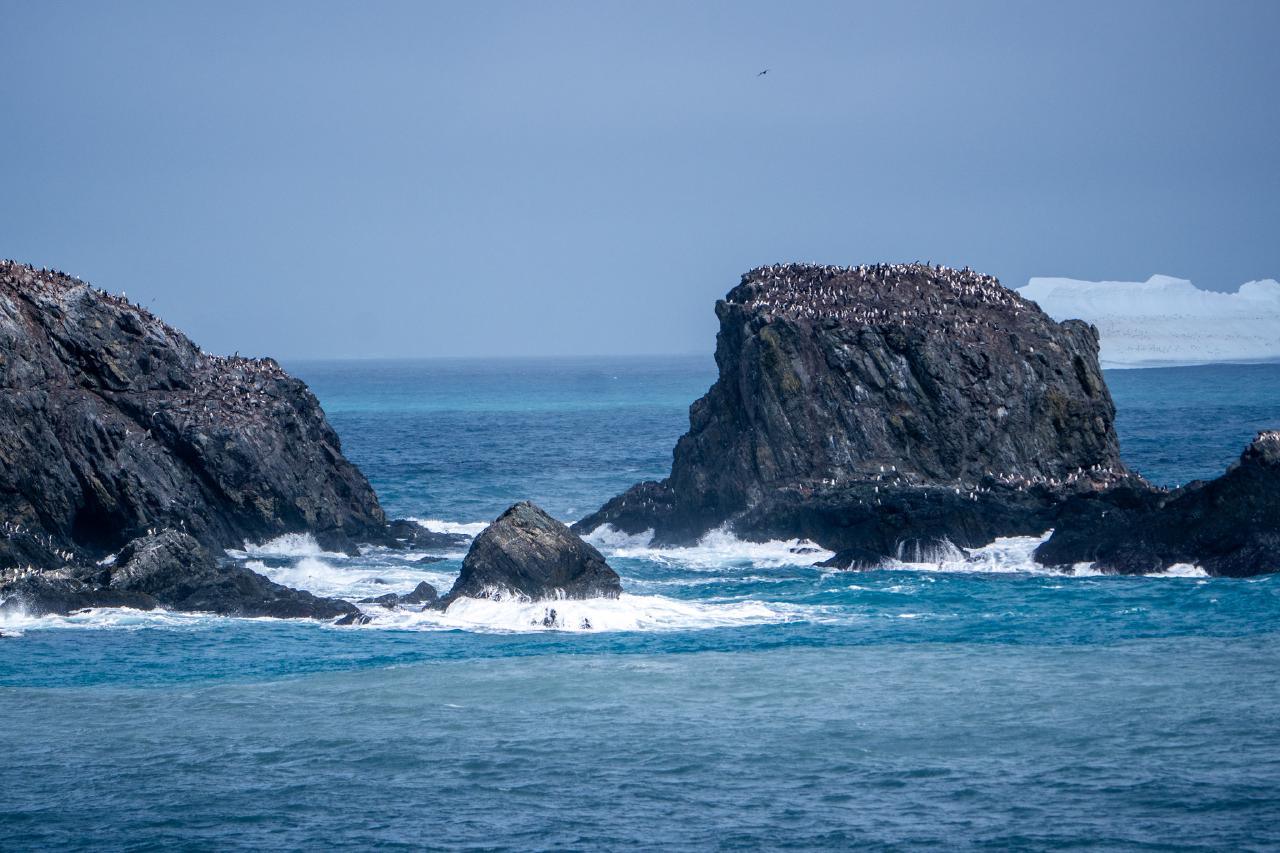When I was 15, I wrote a small, five item travel bucket list. At the top of the list was Antarctica. Twenty years later, I have completed the list, more than ten years after I ticked off the other four items. So, it was with an enormous amount of anticipation that we embarked on our trip to the seventh, and final, continent.
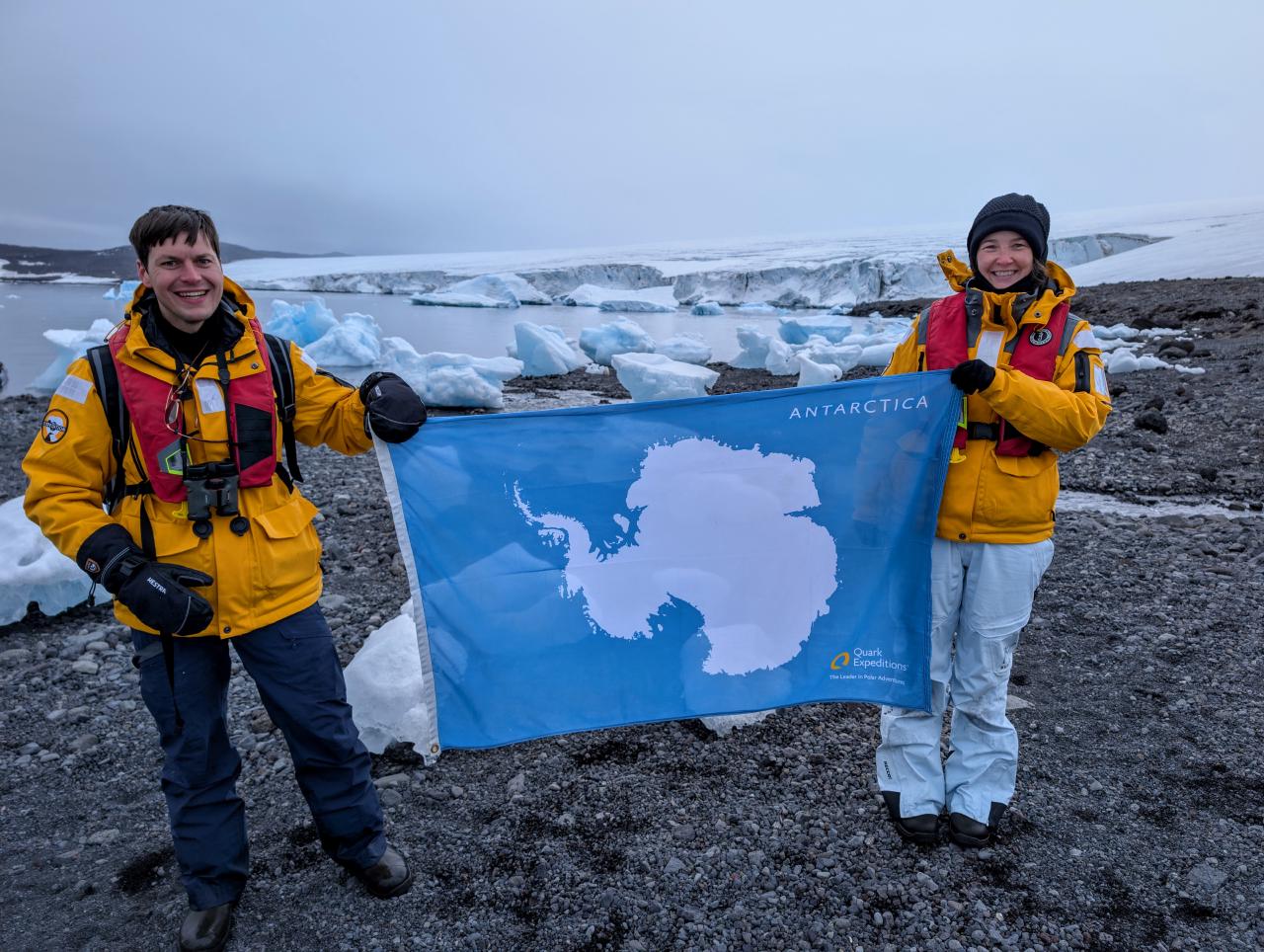
Arriving on the seventh continent
Our tour was the 18-day expedition cruise dubbed the ‘Penguin Safari’ with Quark Expeditions, a reputable leader and operator in polar expeditions. As well as the obligatory visit to the Antarctic Peninsula, our itinerary also included the South Atlantic Ocean island and wildlife mecca of South Georgia.
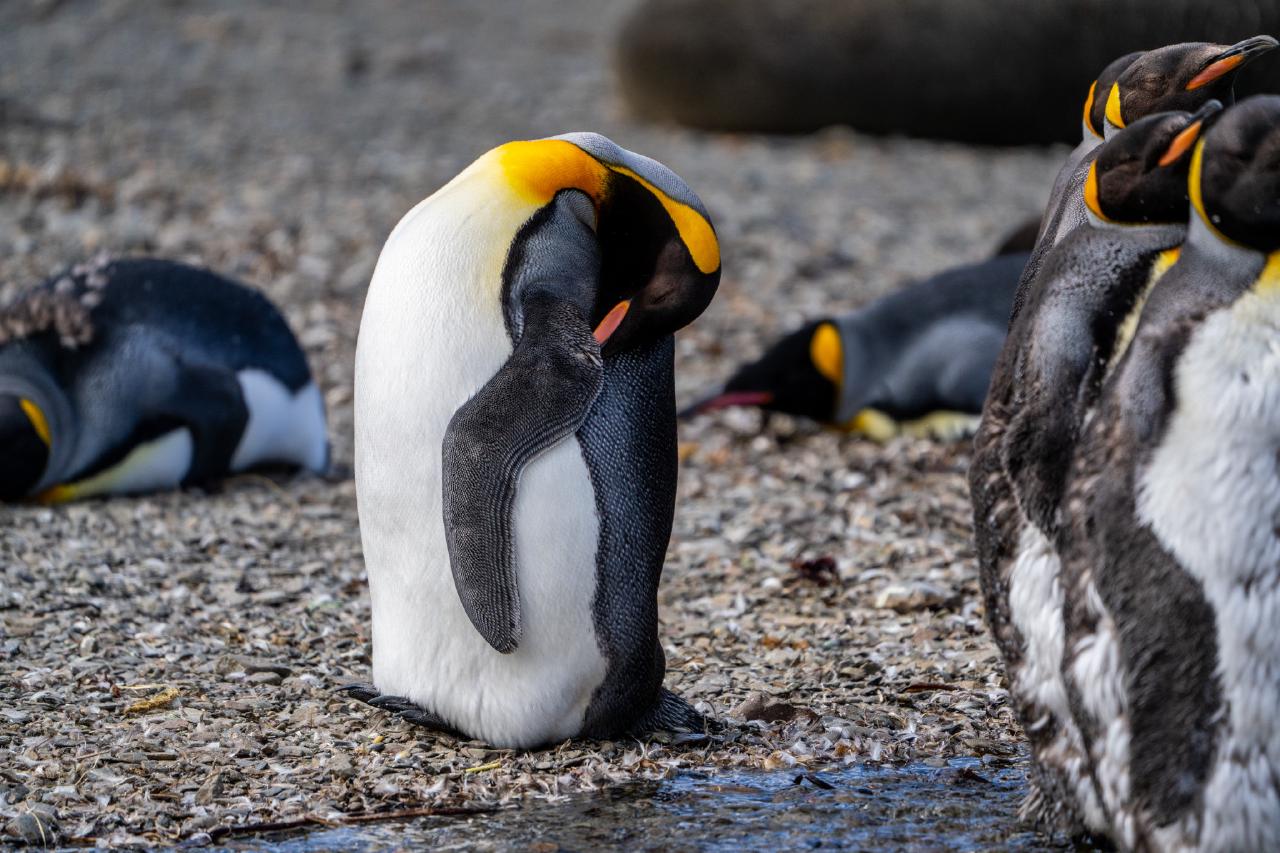
King penguins at South Georgia
Our cruise left from Ushuaia; a small port town known as el fin del mundo due to its very southerly location on the Tierra del Fuego archipelago at the bottommost tip of Argentina. To get there, we flew from Sydney to Santiago and then transferred to Buenos Aires. After a few nights in the Argentine capital enjoying steak and malbecs, we once more flew south to the small town surrounded by ice-capped mountains at the end of the world.
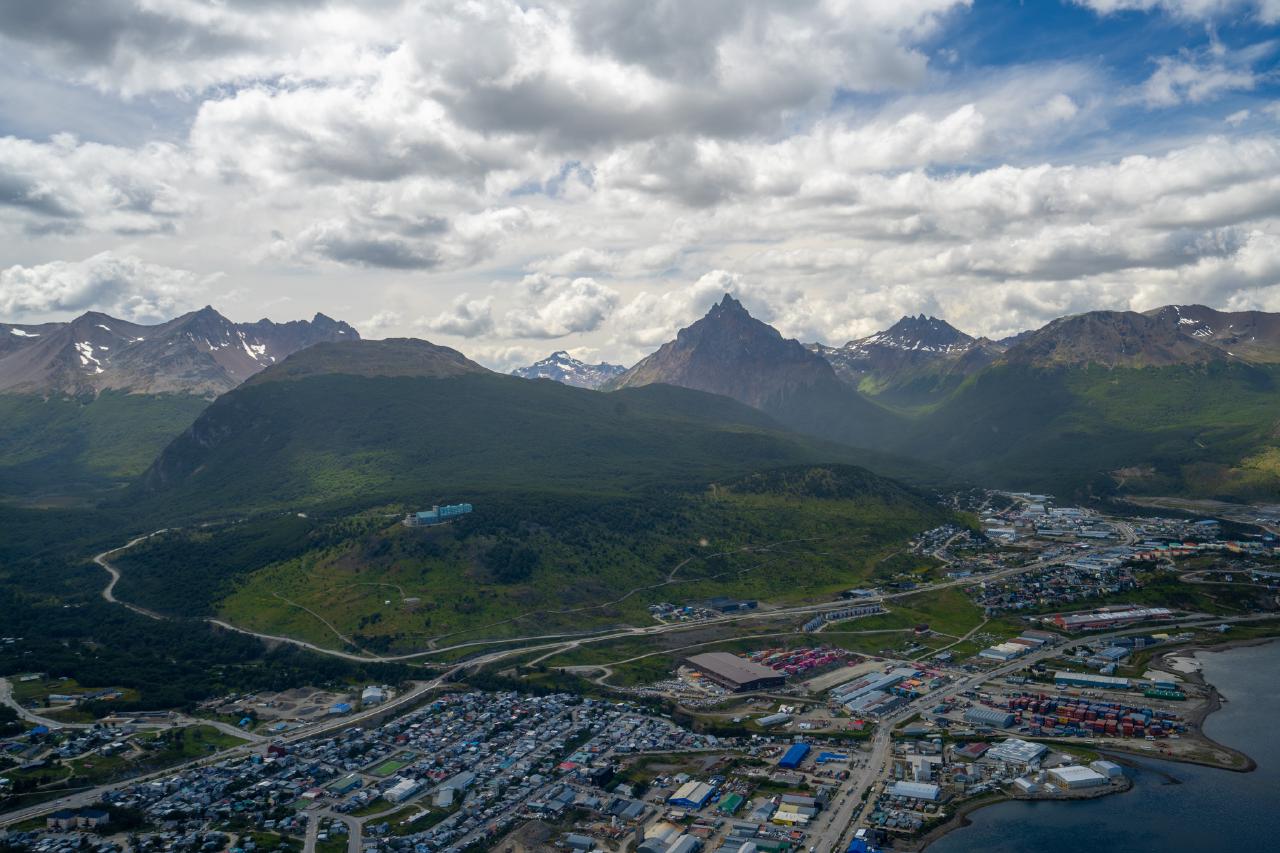
A view of Ushuaia from a helicopter flight
We spent two days visiting the town, having arrived early to ensure we were prepared for any flight delays or lost luggage that could cause, at best, a serious inconvenience, or at worst, missing our ship’s departure. The highlight of our short stay was the 1.5 hour helicopter tour we took. We were flown up into the mountains where we could see a dizzying range of turquoise and aquamarine glacial lakes hidden between glacial valleys and snow-covered peaks.
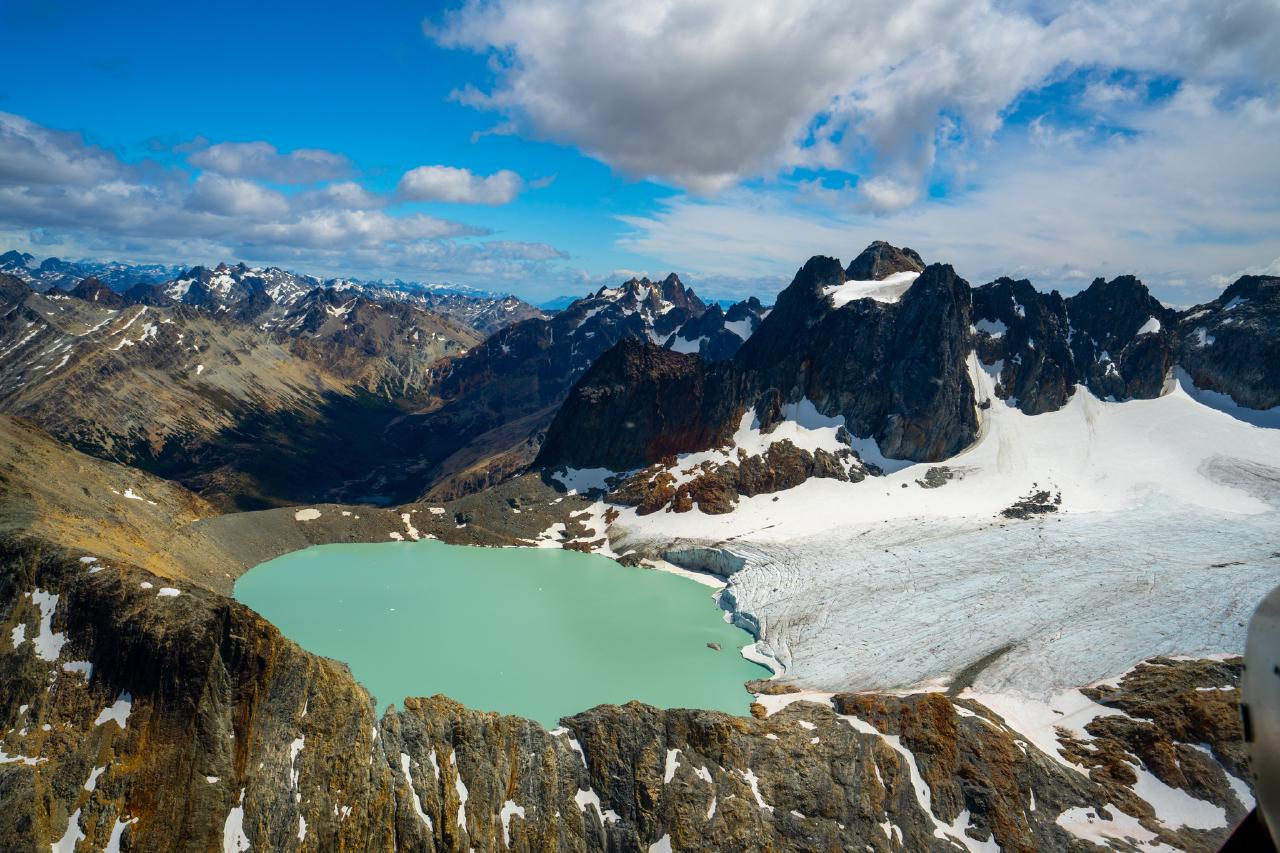
Glacial lakes viewed from the helicopter
The pilot landed us on the pebbled shore of a cold, deep lake whose water’s edge was crystal clear and reflected the surrounding mountains. He delivered a glass of sparkling wine and we drank as the stunning scenery enveloped us. The air was so cool and fresh up there that it felt as though it penetrated deep into your lungs with just one intake of breath.
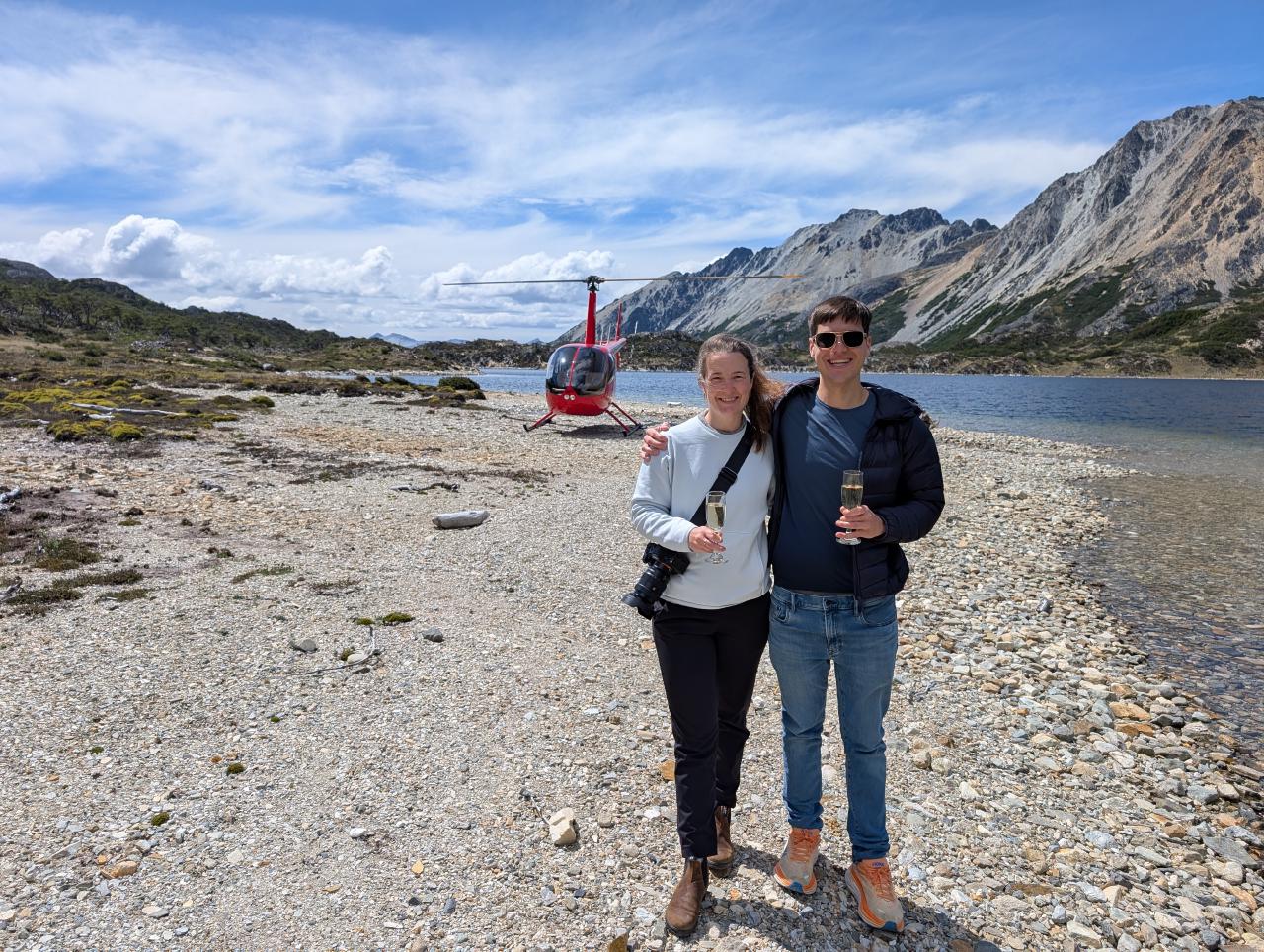
Drinking a glass of bubbles on top of a glacier
In town on the following night, we enjoyed a fantastic meal at Kaupé restaurant. It was tucked away at the back of the town, up a small hill, hidden from the tourist throng. The view from the large rectangular dining room windows was beautiful, with a flower-filled garden in the foreground, the town and port spread out below, and the mountains off into the distance. We learnt that the blue skies and light breezes we experienced those two days was very unusual, and we hoped the weather would continue to bless us with calm seas for our onward voyage the next day.
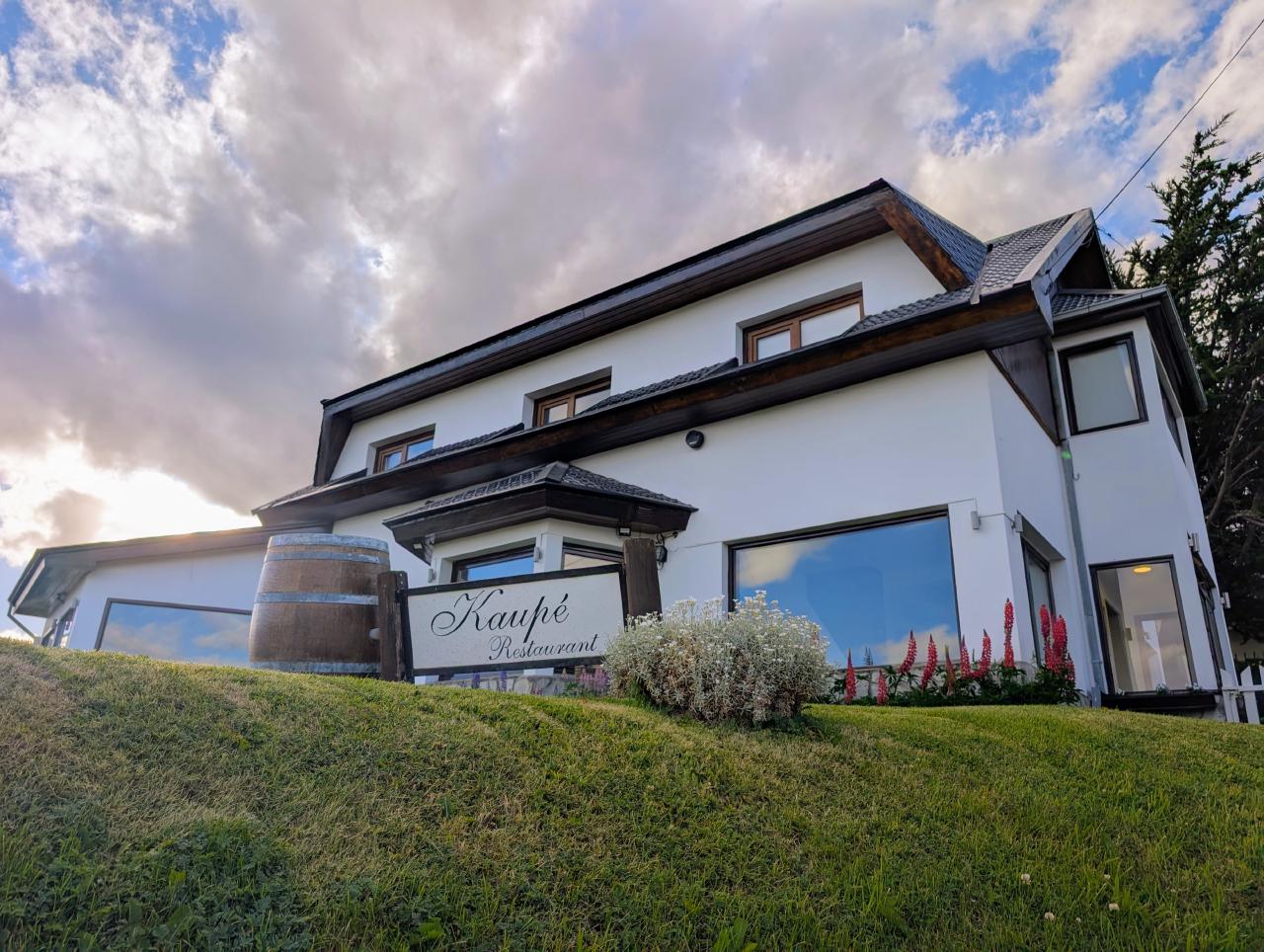
Dinner at Kaupé restaurant
From this gateway to Antarctica, we departed on our cruise. Our embarkation was delayed and so we didn’t board the buses the following day until about 5.00pm. The buses took us the short distance along the port to where our ship - the World Explorer - and home for the next 18 days, was berthed. We were greeted onboard the ship with a glass of champagne in the lounge as we waited for our turn to check into our room.
Our cabin - room 540 - located on deck 5, towards the stern of the ship, was a beautiful, well-appointed room, which in addition to the large bed and ensuite bathroom, had a seating area, desk and floor-to-ceiling window. After taking note of our yellow, all-weather expedition parkas and refillable water bottles, we unpacked our clothes into the wardrobe before making our way through the maze of corridors to the staircase to head down to the dining room on deck 4.
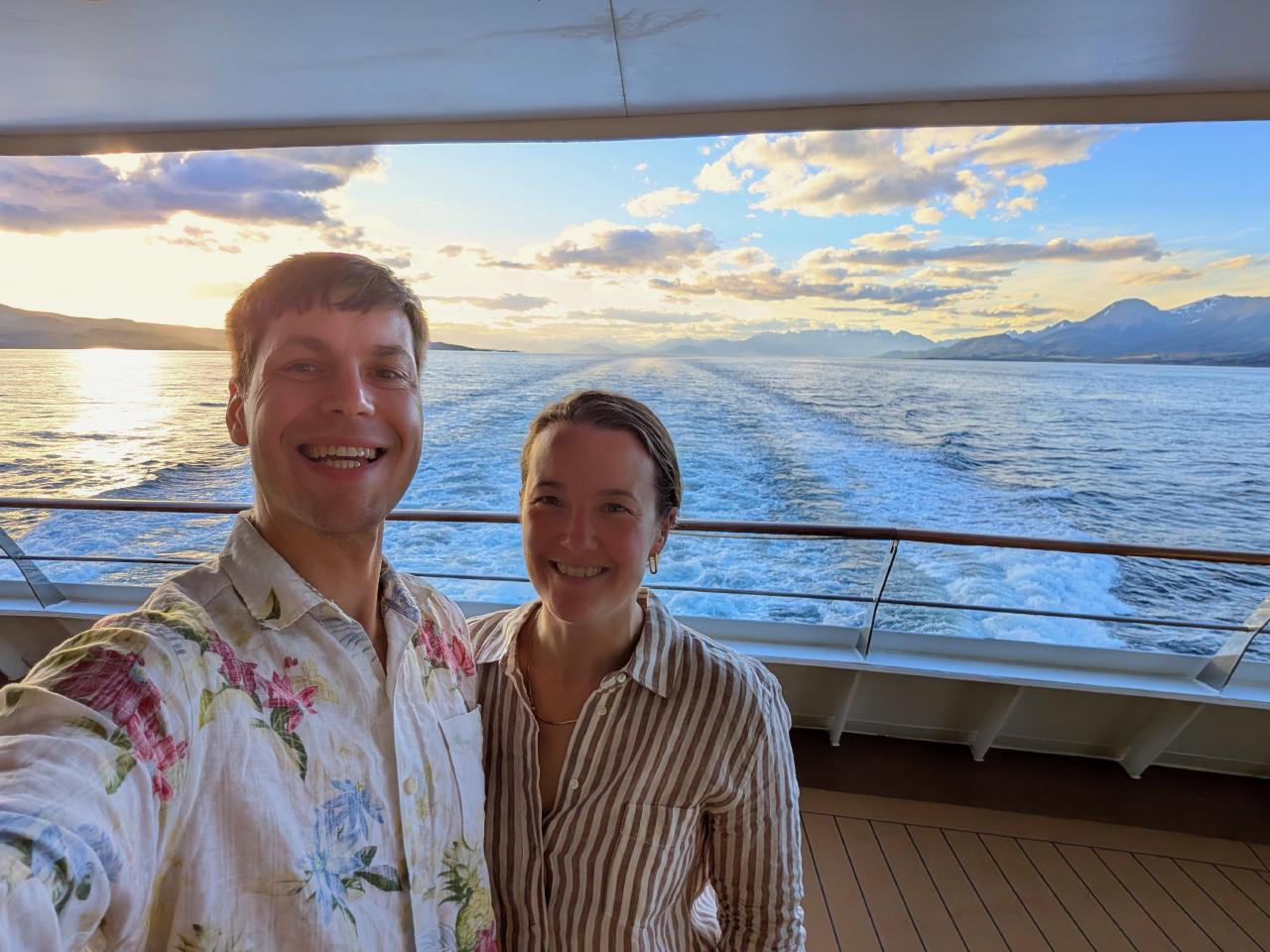
Standing on the deck behind the dining room
We enjoyed a buffet dinner as the ship departed from its dock and progressed through the Beagle Channel. After dinner, we stood on the outer observation deck on level 7 along with some of the guides and other guests as the summer sun slowly sank below the horizon to cast an orange glow. As we navigated down the calm passage, we caught our first glimpses of penguins, jumping in and out of the waters below the ship. Our penguin safari had officially began; with the sighting of the magellanic penguins.
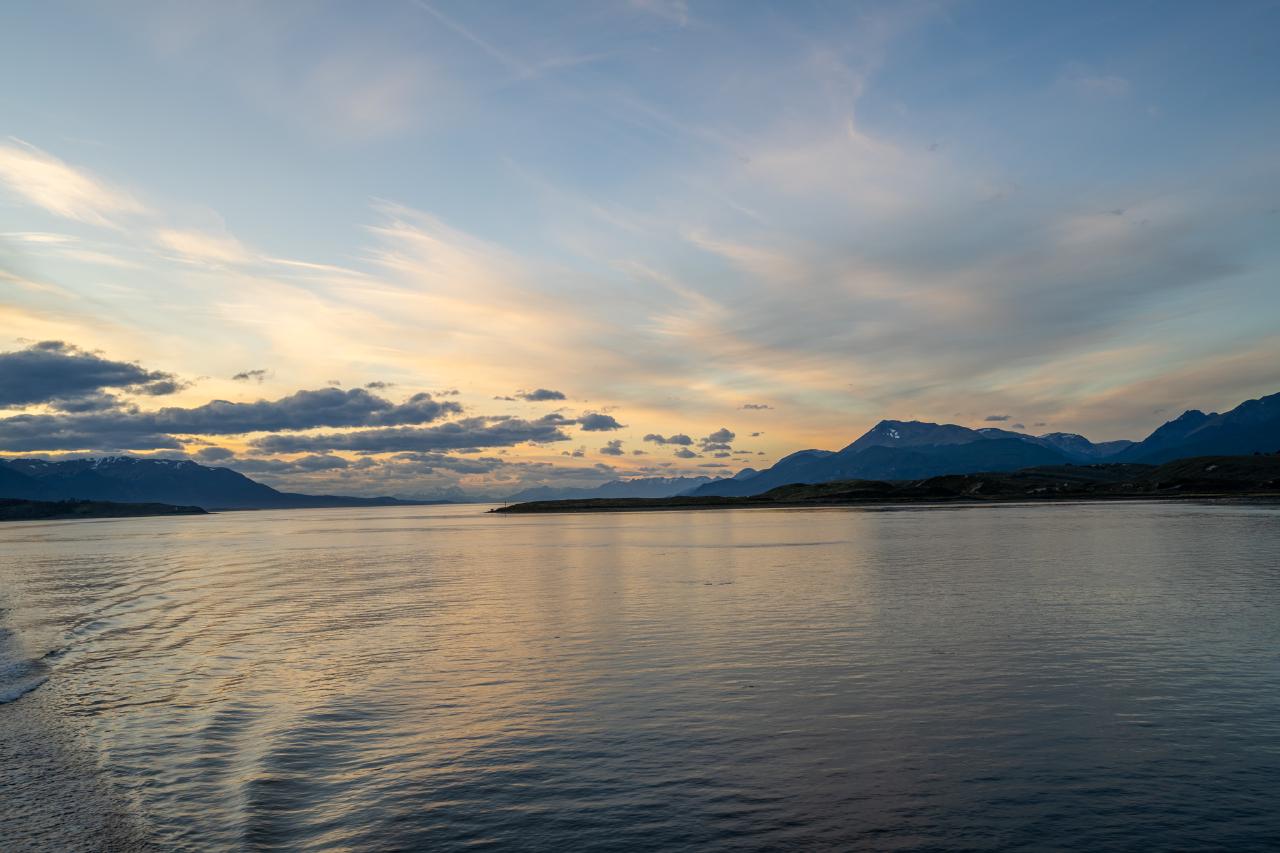
Sunset along the Beagle Channel
During the night, while we slept in our comfortable bed, the ship emerged into the open ocean, and the swelling seas. While we weren’t sailing directly south through the infamous Drake Passage, our voyage east across the Scotia Sea was nonetheless affected by the same winds that can whip up the ocean in these parts into an insufferable frenzy. At the first sign of motion sickness, I commenced my first dose of sea sickness medication, and kept up regular doses for the next three days as we rocked and rolled across the 7m swells of the South Atlantic Ocean towards our destination.
We travelled at sea, eastwards towards South Georgia, for three days. During the days at sea, we were kept entertained with lectures in the auditorium from our engaging and experienced expedition guides. The onboard ornithologist, Matt, marine biologist, Alex, and geologist, Greg, gave lectures on a variety of relevant topics.
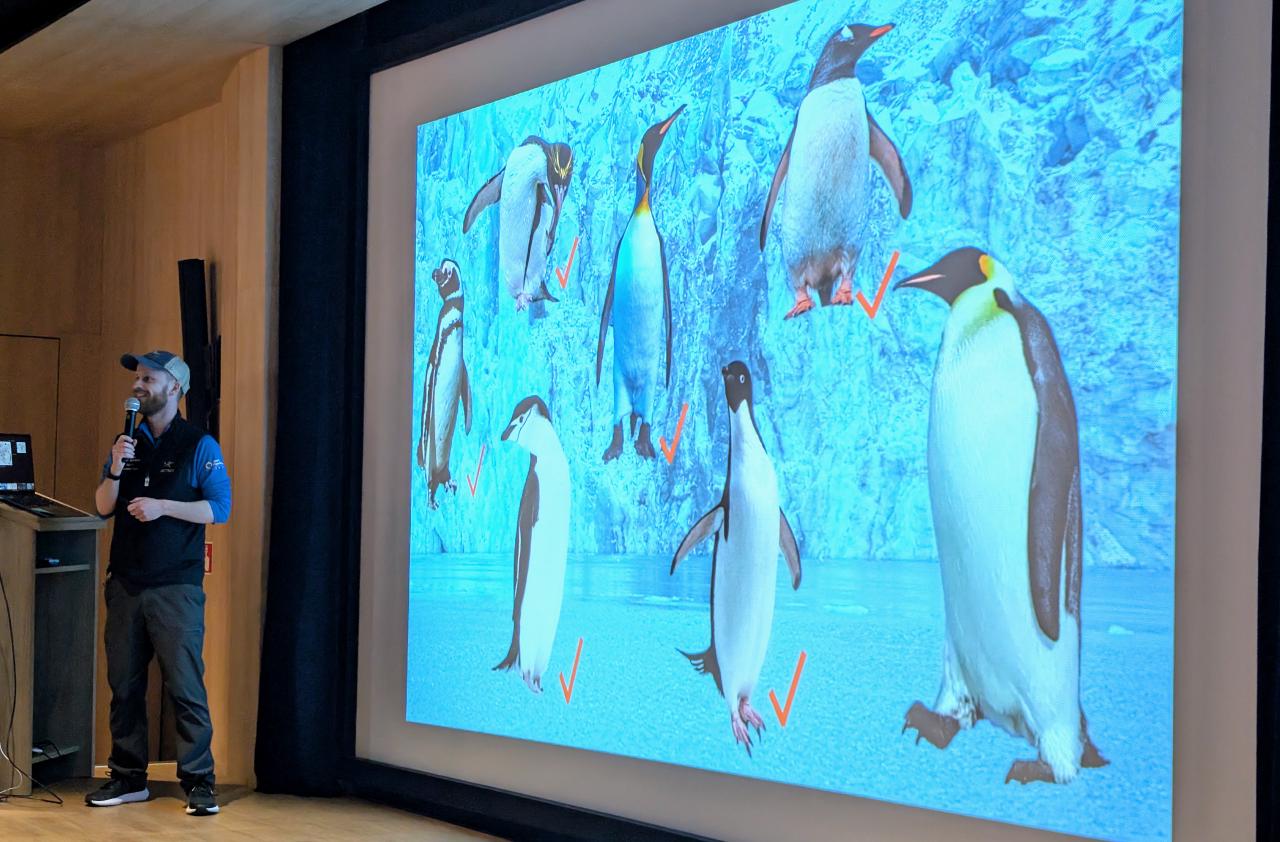
Matt giving one of his talks on penguins
Resident historian, Colin, also taught us about the history of Antarctic exploration and the conflicts in the Falklands and South Georgia. To complement our learning, we watched the 2002 TV mini series ‘Shackleton’ starring Kenneth Branagh as the titular character. Our 18 day journey would be visiting many of the same locations as the famed explorer – including South Georgia, Elephant Island and the Weddell Sea – and so it was with renewed appreciation of their perilous and implausible expedition that we undertook our comfortable and reliable one.
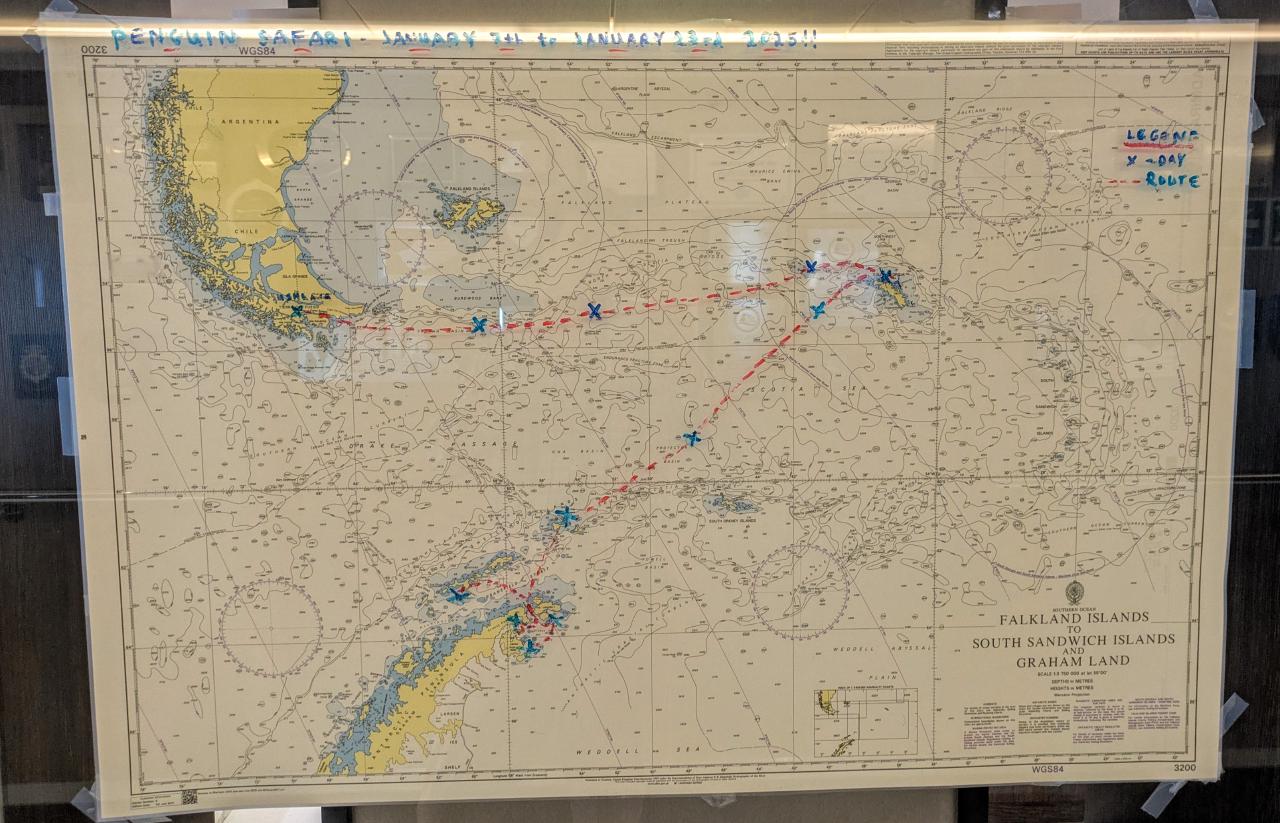
A map of our voyage
Our ship also hosted two scientists, Tom and Jasmine, whose work involves the research and conservation of penguin colonies through their universities and the organisation called Penguin Watch. They shared their research with us during the voyage and during our landings and excursions they flew their drones to count and analyse the penguin colonies we visited.
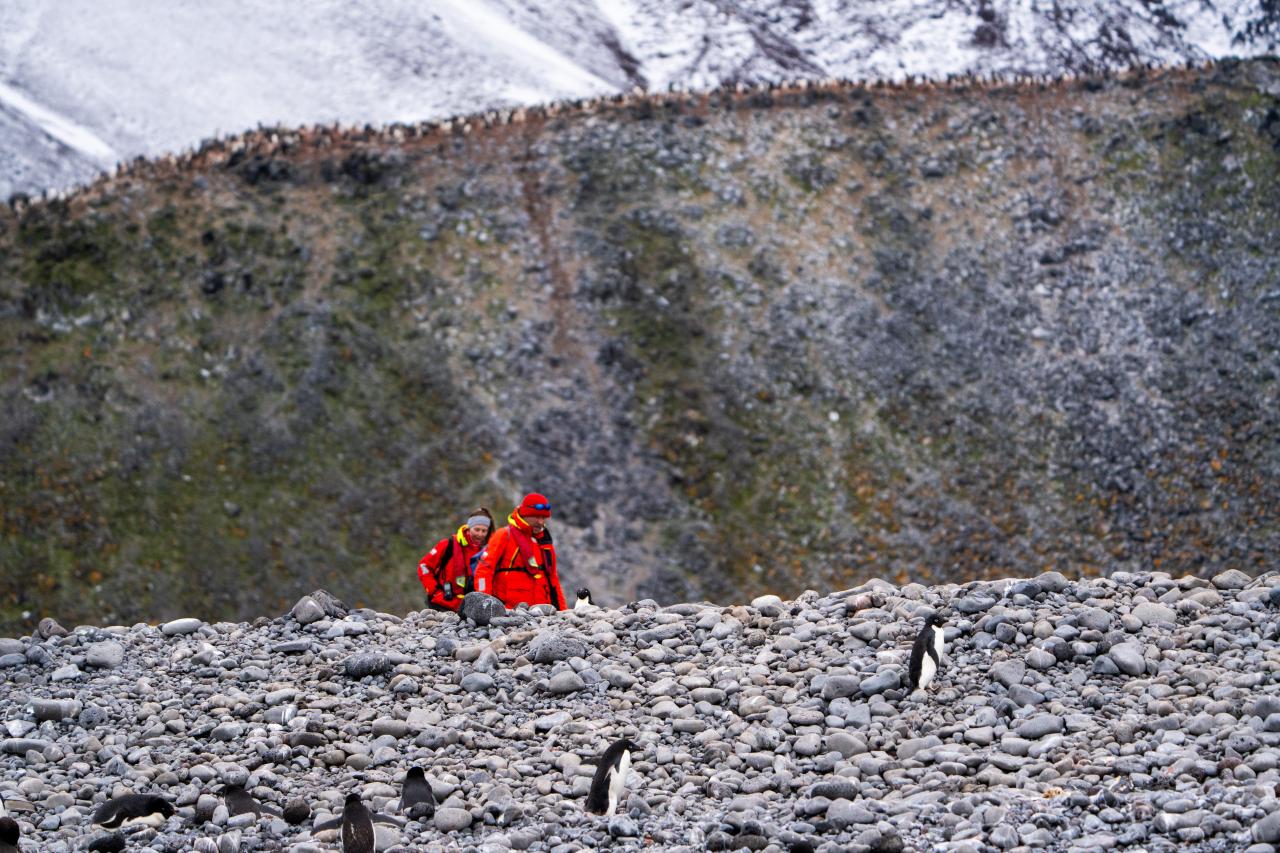
Tom and Jasmine on Paulet Island
In between the educating seminars and our multi-course meals at breakfast, lunch and dinner, we went once to the onboard gym (until movement that required less than 3 points of contact with the ship became entirely impracticable) and slipped into the bubbling hot tub on the level 7 open-air deck. Inexplicably, it seemed to quell the nausea to be within moving water when the water around you was moving. Or perhaps it was simply the relief of cold fresh sea air to inhale.
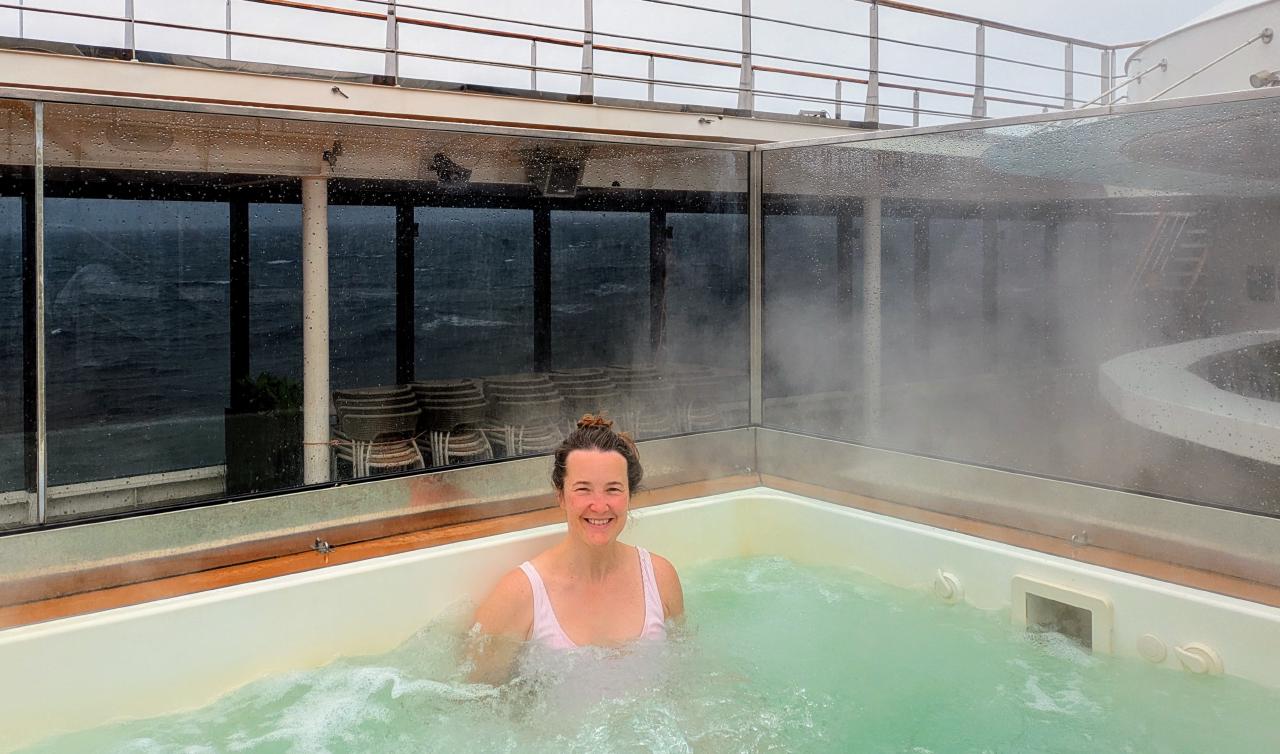
Me in the hot tub on deck 7
And every evening we gathered in the auditorium to listen to our expedition leader, Shane, provide a debrief on the day’s activities and a briefing and weather report for the next day. We became abnormally obsessed with wind forecasts and the size of the ocean swell. There was a large storm tailing us and moving in the same direction. I was not interested in finding out what 9 or 10 metre swells felt like, and hoped we continued to stay ahead of it.
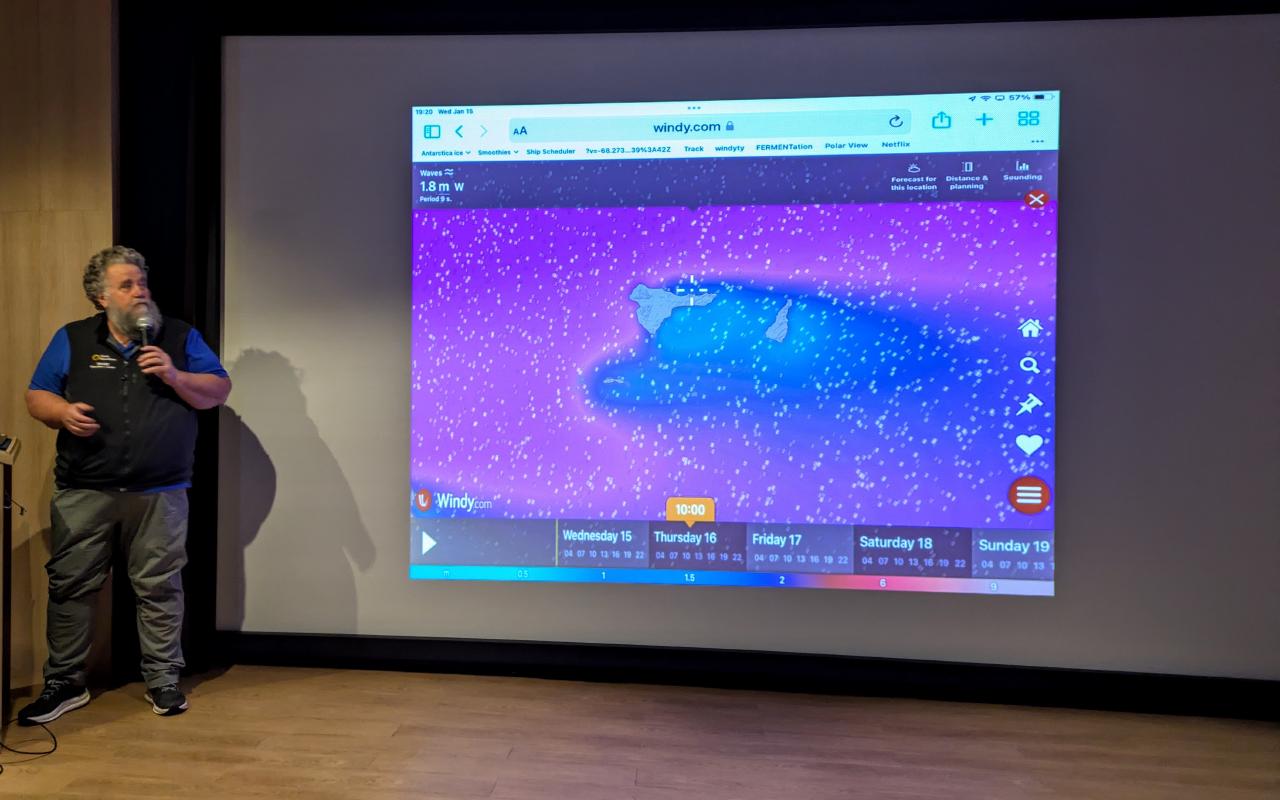
Shane giving his daily weather report
On the morning of our third full day at sea, we approached Shag Islands, a series of small, jagged islets jutting out of the turbid sea, and indicating the approaching landmass of South Georgia. Flocks of shags circled above and beyond the ship, as we continued south-east towards our destination.
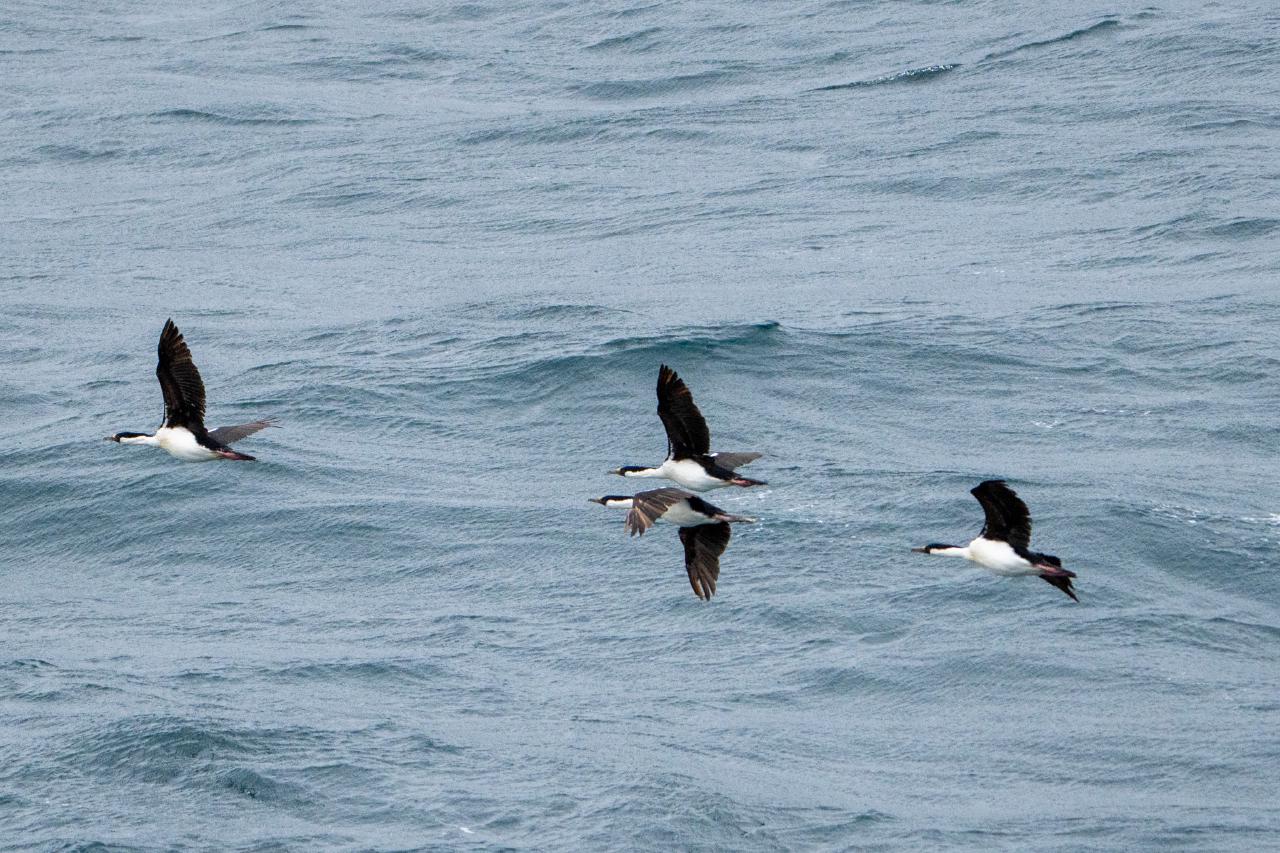
Shags circling around the ship at Shag Rocks
South Georgia is a globally important breeding site for many species of sea birds, and is home to one of the largest colonies of king penguins anywhere on the planet. It is teeming with wildlife, but it is only recently that the wildlife has reclaimed the island and its surrounding waters.
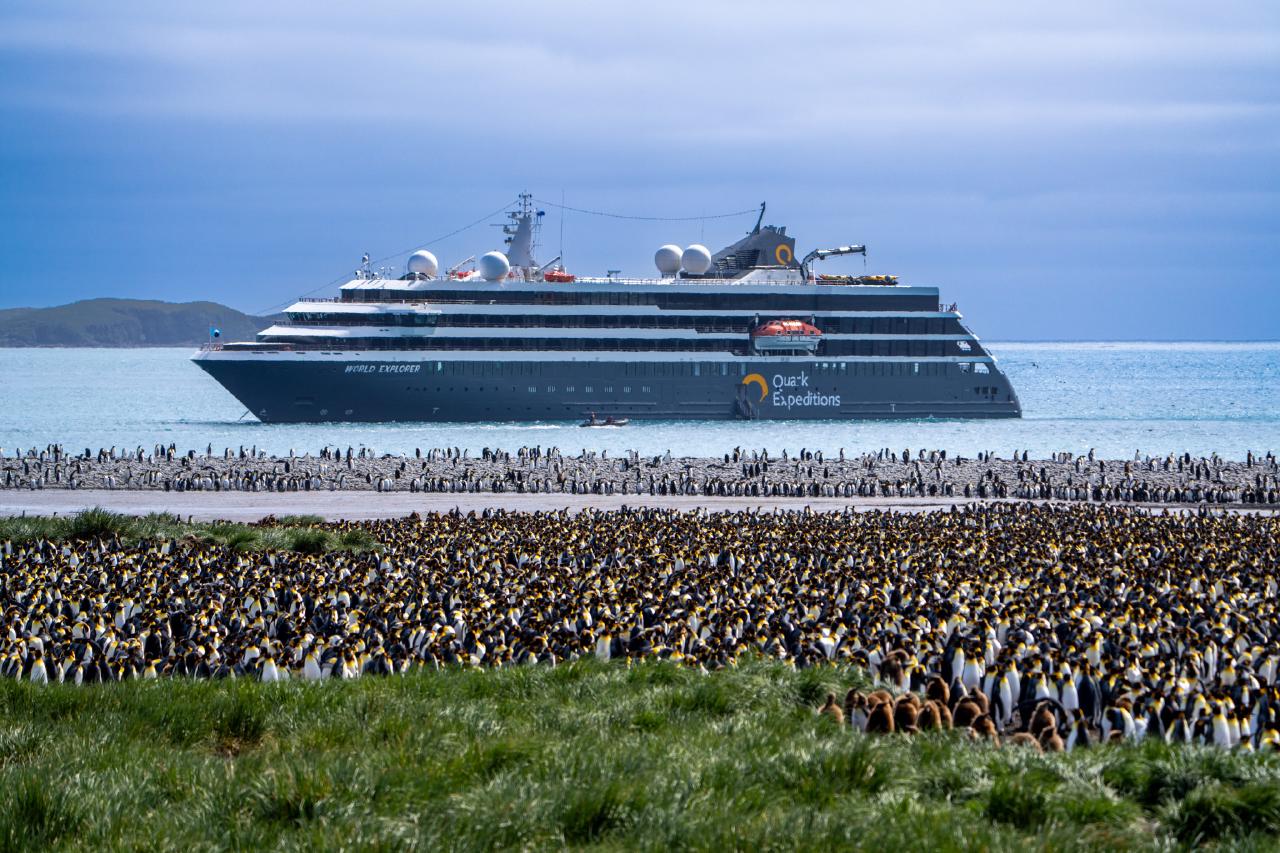
The colony of king penguins at Salisbury Plain in South Georgia, one of the largest on the planet
After more than a century of human occupation and exploitation for commercial whaling and sealing, the wildlife was pushed to the brink of extinction. However, the cessation of whaling and sealing, and the successful eradication of introduced rats and reindeer from the island, along with the consequent establishment of the largest protected marine area at the time, has transformed South Georgia. The wildlife has reclaimed the island and its surrounding fertile waters.

Fur seals and king penguins occupying the beaches in South Georgia
Now, enormous elephant seals, that were nearly hunted to extinction in the 19th century for use in oil lamps, occupy the beaches in their hundreds. The endemic South Georgia pipit that also nearly disappeared forever now nests once more in the tussac grasses, its unique bird song drifting on the wind in whose currents the wandering albatross soar and slope, gliding for days without any need to flap. The giant petrels ride effortlessly on the ocean swell. The innumerable fur seals share the beaches with the king penguins which stand majestically on the shore, the golden teardrops of their plumage a vivid highlight in an otherwise mass of black and white.
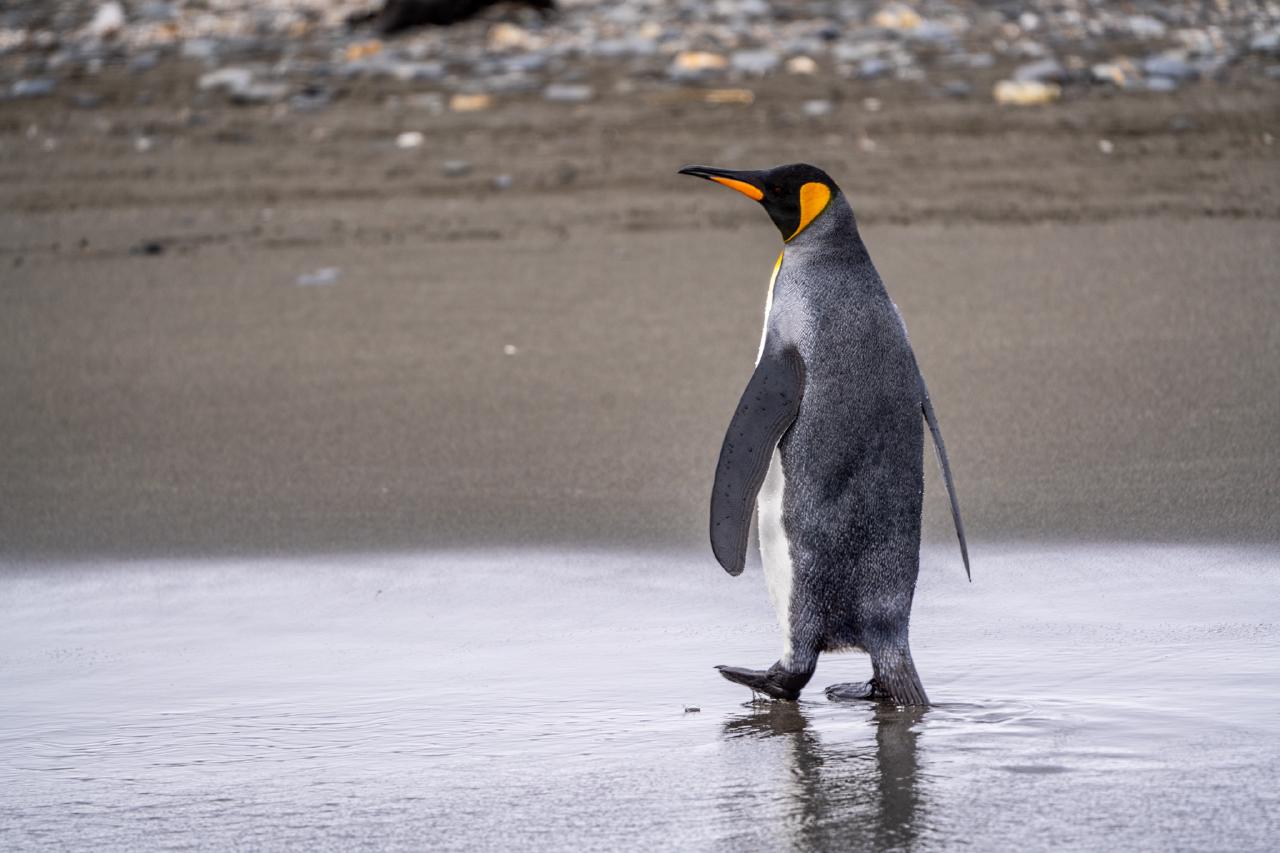
The golden teardrop marks the crown of the majestic king penguin
And we got to see it all. An island of diverse and abundant wildlife in this far-flung place on earth.
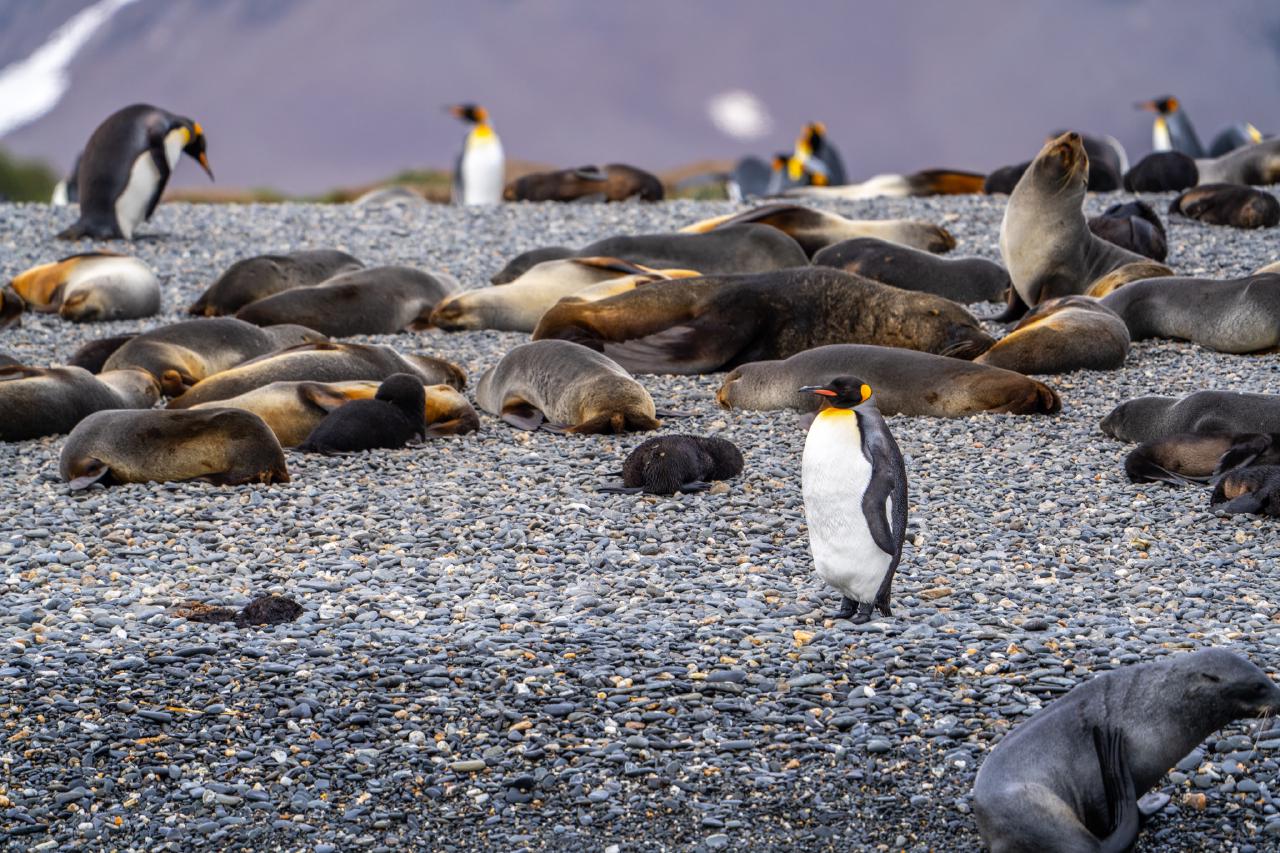
Fur seals and king penguins on South Georgia
11 January, Stromness + Grytviken
We arrived in a secluded bay of South Georgia in the early hours of the morning. We were woken with a wakeup call from Shane over the PA system, the notable stillness of the ship alerting us to our arrival at Stromness before his announcement broadcast the same. Dylan leapt out of bed and drew back the floor-length, heavy curtains at our cabin window to reveal a near cloudless blue sky whose shower of sunlight turned the water below a sparkling shade of turquoise. We had found ourselves in a calm oasis as the storm swirled in the ocean beyond the protected cove of the island.
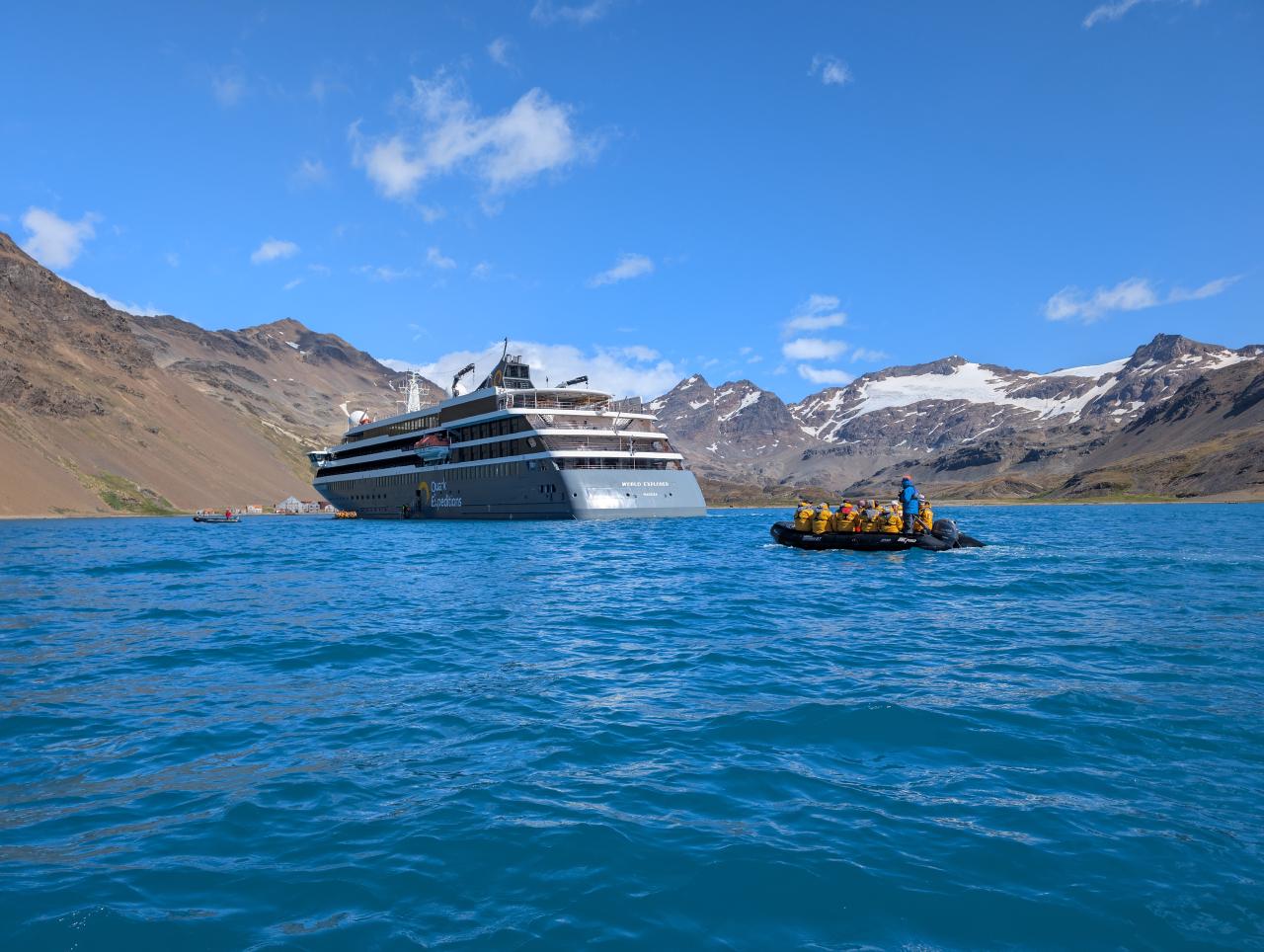
The calm waters for our zodiac cruise at Stromness
The vision of land, and a calm sea, for the first time in three days was unexpectedly exciting. After breakfast, we prepared ourselves for our first excursion. We had received biosecurity training during our second day at sea and were now trained to spot and remove tiny seeds and unsuspecting fluff that might introduce unwanted life into this special place. After being called and completing our checks, we walked out on the gangway to board our first zodiac ride of the trip. The waters were calm and we stepped easily off the metal grate of the gangway and onto the thick rubber edge of the zodiac before taking a seat and grasping the black rope running along the length of the zodiac for support.
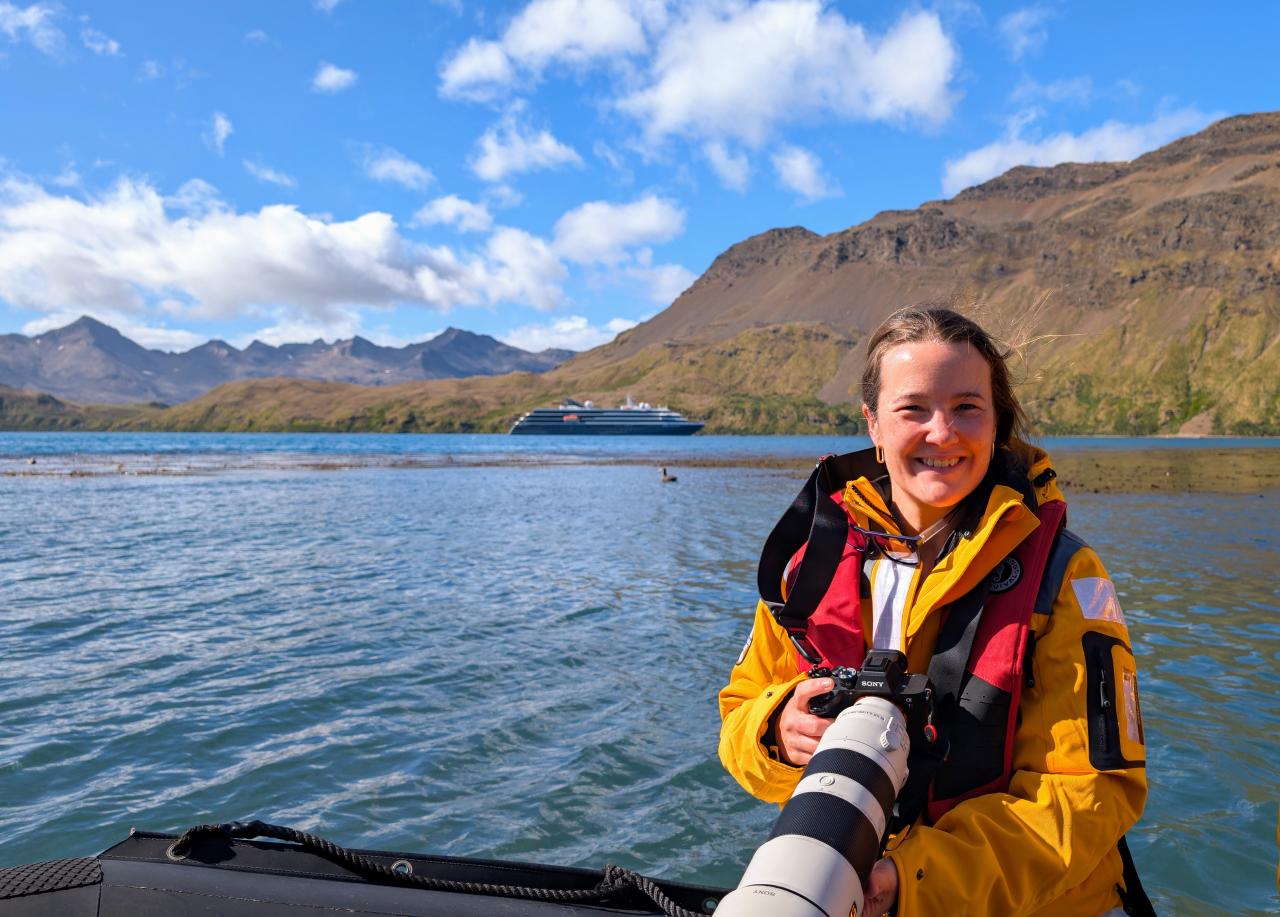
Enjoying our first zodiac cruise at Stromness Bay
With our guide, we spent an enjoyable 90 minutes cruising around the sun-filled bay of Stromness. It was a spectacular day and the sun felt warm on our faces.

Viewing the wildlife from the zodiac at Stromness
We saw fur seals playing in the water and massive elephant seals heaving on the beach. The petrels came right up to the boat to check us out. Penguins waddled on the shore and swam through the water. We were immediately eager for more.
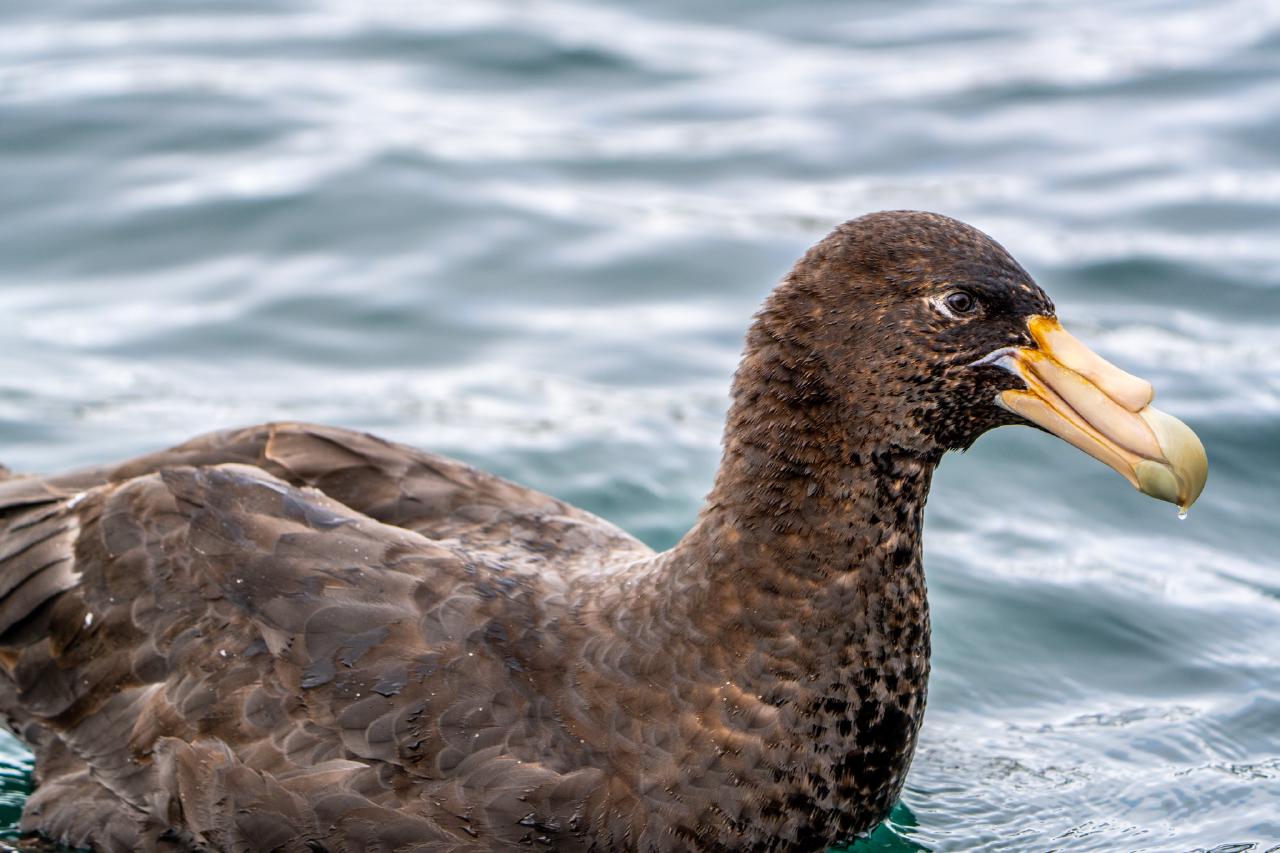
A petrel
After lunch, we had our second excursion, which was a shore landing at Grytviken, the site of a former whaling station, on the north side of the island. Ernest Shackleton is buried here, after dying upon his arrival here before the departure of his fourth Antarctic expedition. We visited his grave, a large tombstone in a small grassy graveyard surrounded by a weather-worn, wooden fence, looking out over the bay below. We made a toast with a nip of whisky, and then walked into the centre of the historic town, carefully weaving our way between fur seals and their pups who occupied nearly every available space.
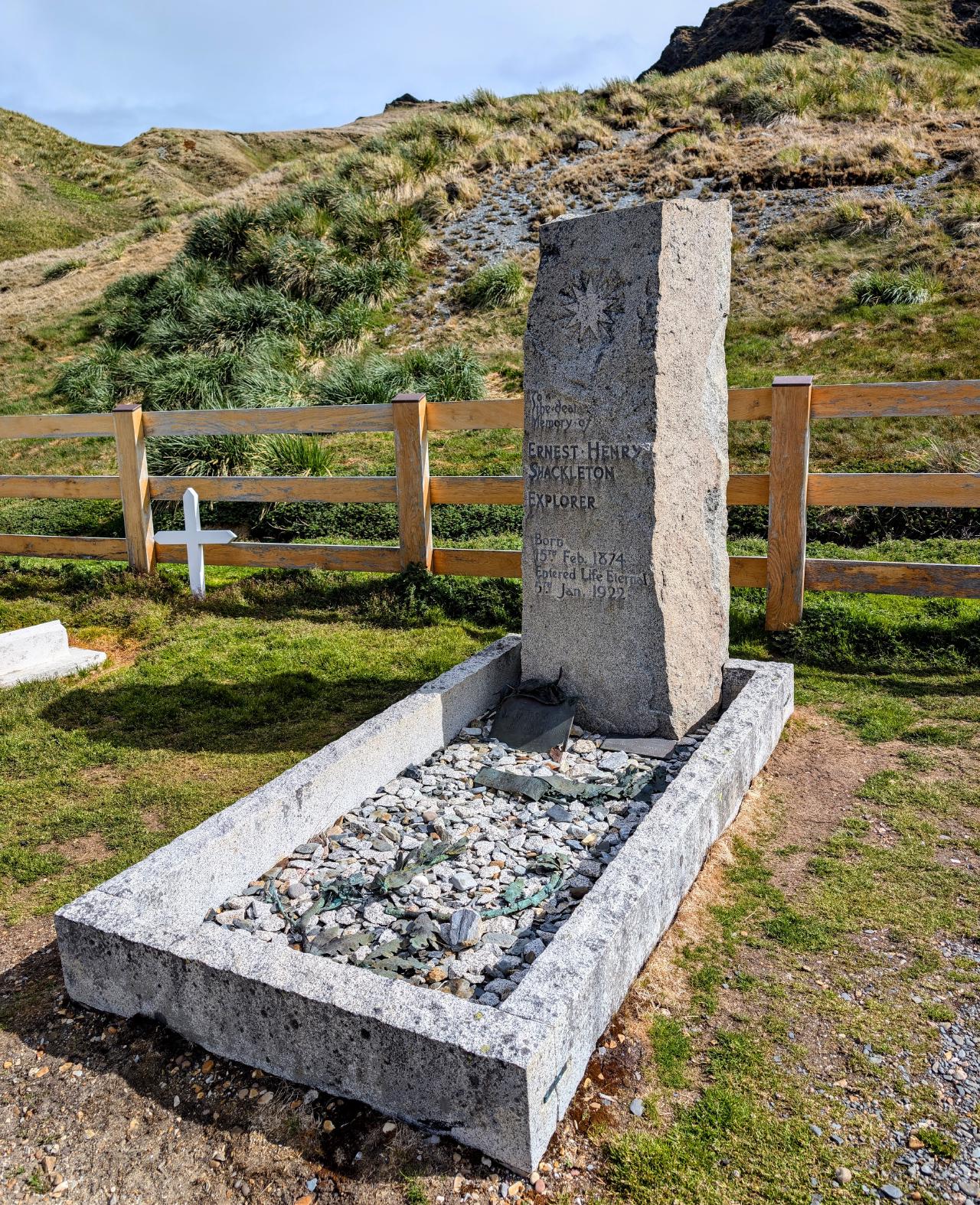
Ernest Shackleton's grave on the grassy hillside at Grytviken
We wandered among the abandoned ruins of the station, the rusted machinery and whaling boats left in place as the last of the whalers departed. We visited the old store shed, which at its peak of operation, housed enough materials to build a new ship from scratch.
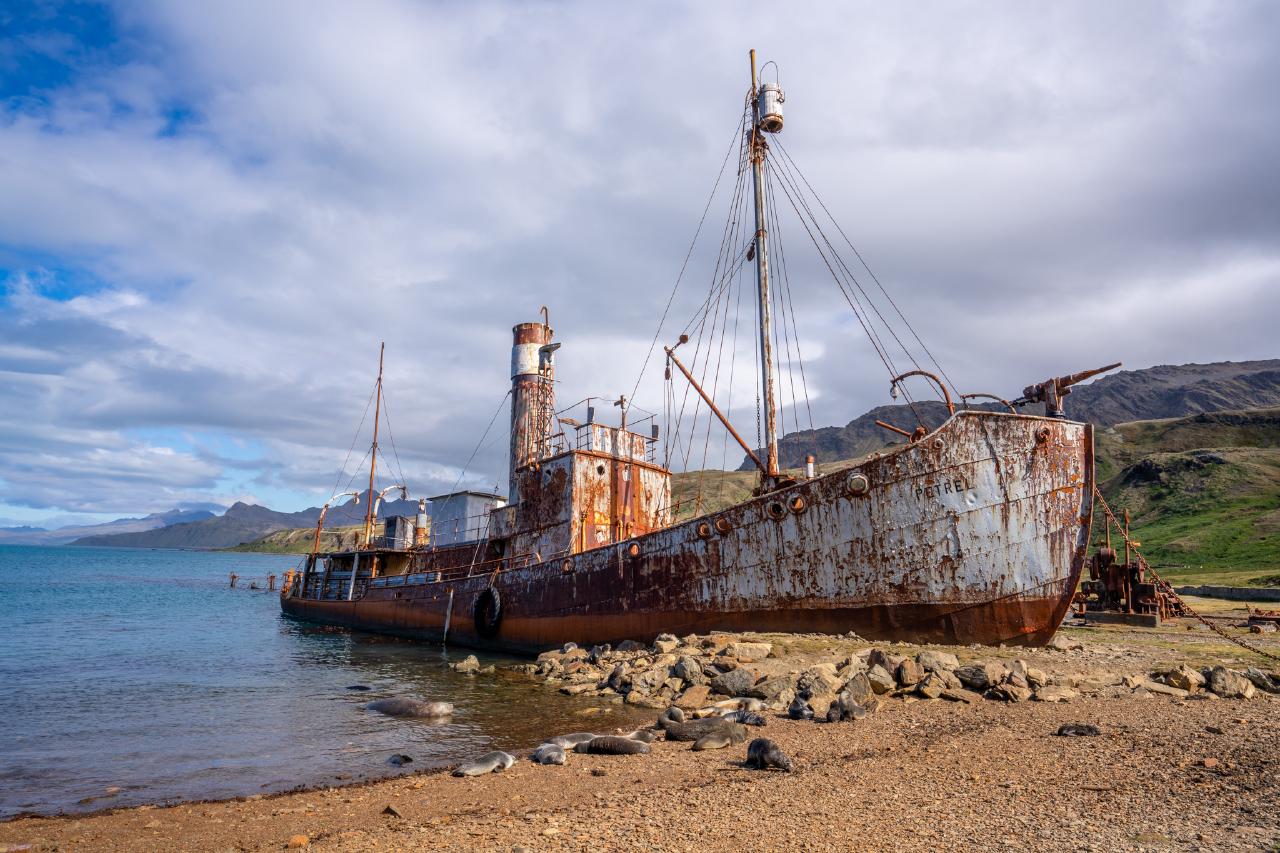
Former whaling ship, the Petrel, abandoned at Grytviken harbour
We wandered up the hill to the old church, and explored the museum operated by the South Georgia National Trust, always navigating the locals and trying hard to maintain our distance from the curious seal pups and giving way to the crossing of king penguins over well-established penguin paths.
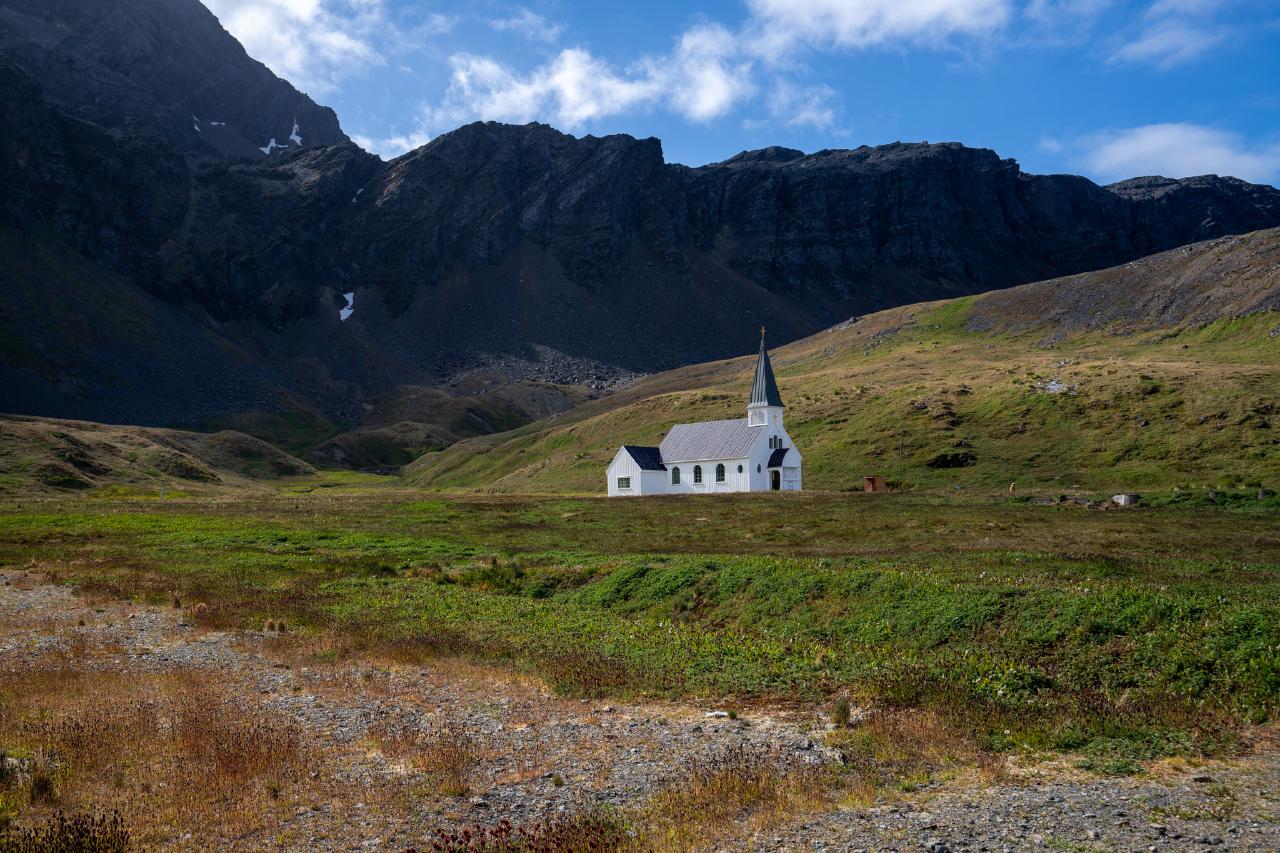
The old church at Grytviken
The space was reclaimed by the creatures who nearly vanished from its shores.
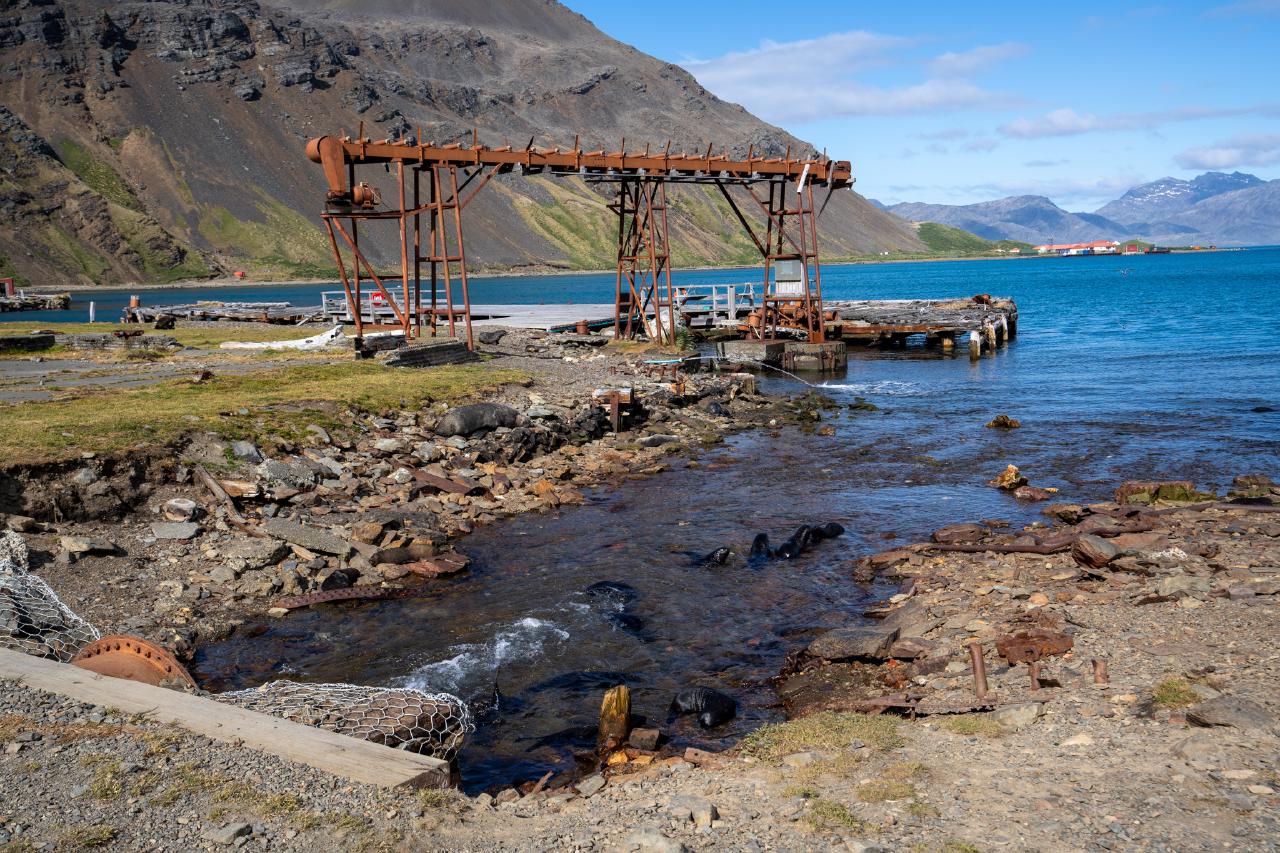
Seal pups playing in the turning torrent at the water outlet
At around 5.30pm we took a zodiac back to the anchored ship out in the bay and, after cleaning our expedition gear and taking a hot shower, enjoyed a rosé on the level 7 observation deck as the sun slipped towards the horizon. The floor to ceiling windows and 275-degree views provided the perfect vantage point to take in the surrounding landscape while sorting through hundreds of photos and chatting to other guests.
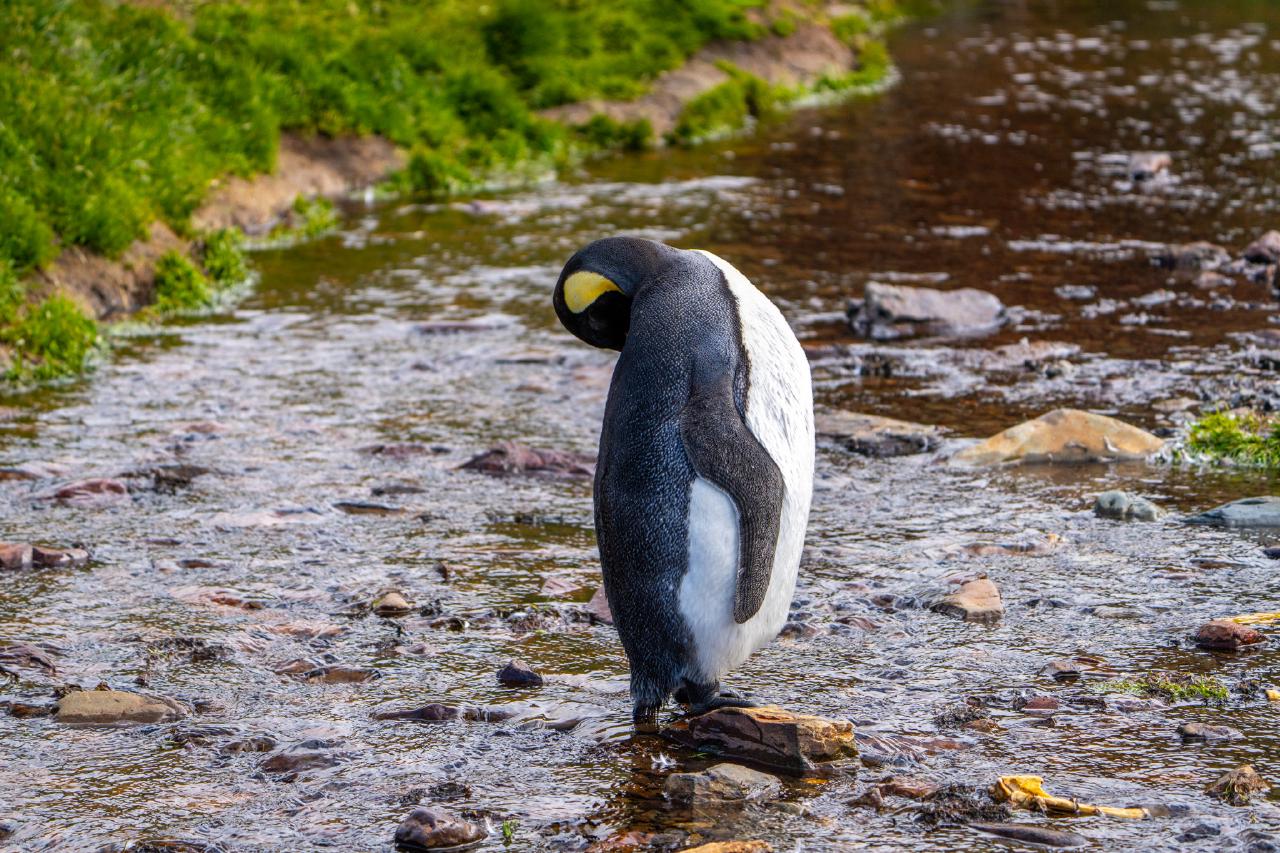
A king penguin at Grytviken
12 January, Salisbury Plain
We were woken by Shane early again on our second day in South Georgia. After an omelette and coffee for breakfast we once more prepared for our first excursion of the day. For the first part, we cruised in and around Bay of Isles along the north-west fjords. We cruised in secluded bays where we found beaches covered in fur seals and king penguins. They were curious and swam in the water around the zodiac.
I never imagined we would see so many penguins jumping in the water, rapidly and effortlessly swimming, perfectly evolved for aquatic movement. I couldn’t stop smiling, watching them dart and dive and roll in the waves to clean their feathers, like a puppy would roll around in the grass to scratch itself.
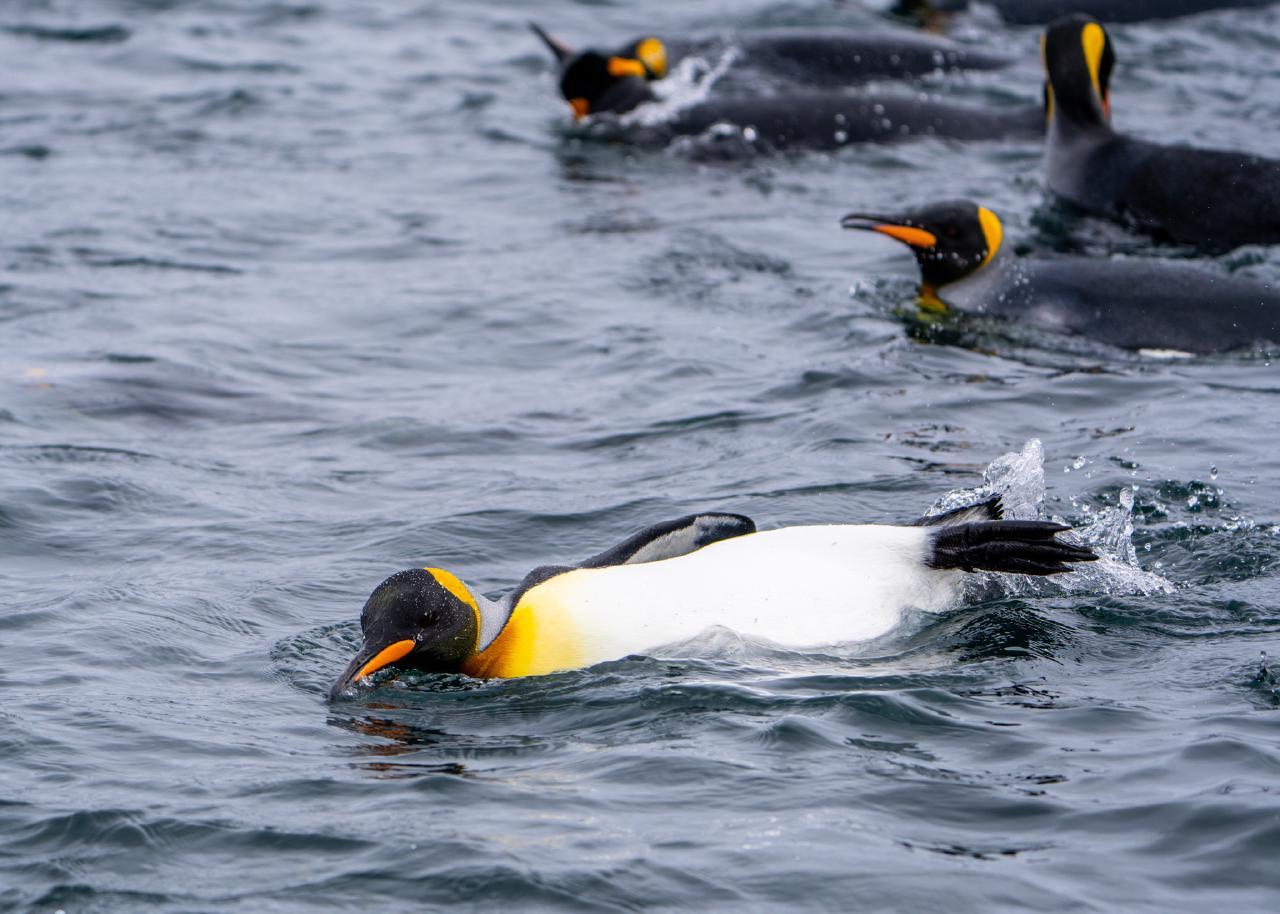
A king penguin rolling in the water to clean its feathers
After nearly two hours of zodiac cruising, our guide landed our little rubber boat at Salisbury Plain; a flat plain formed by the withdrawal of the Grace Glacier, and home to one of the most spectacular wildlife displays on the planet: a king penguin colony hosting around 60,000 breeding pairs. The colony swells to as many as 250,000 individuals when the pairs, their chicks and non-breeding penguins are all on shore for their annual moult. The penguins undergo a ‘catastrophic moult’ which, unlike other birds that gradually lose their feathers, replaces all of the penguins’ feathers at once. It is a month-long process during which the penguin does not eat, and so it was important to give them their space to allow the process to unfold with as little disruption as possible.
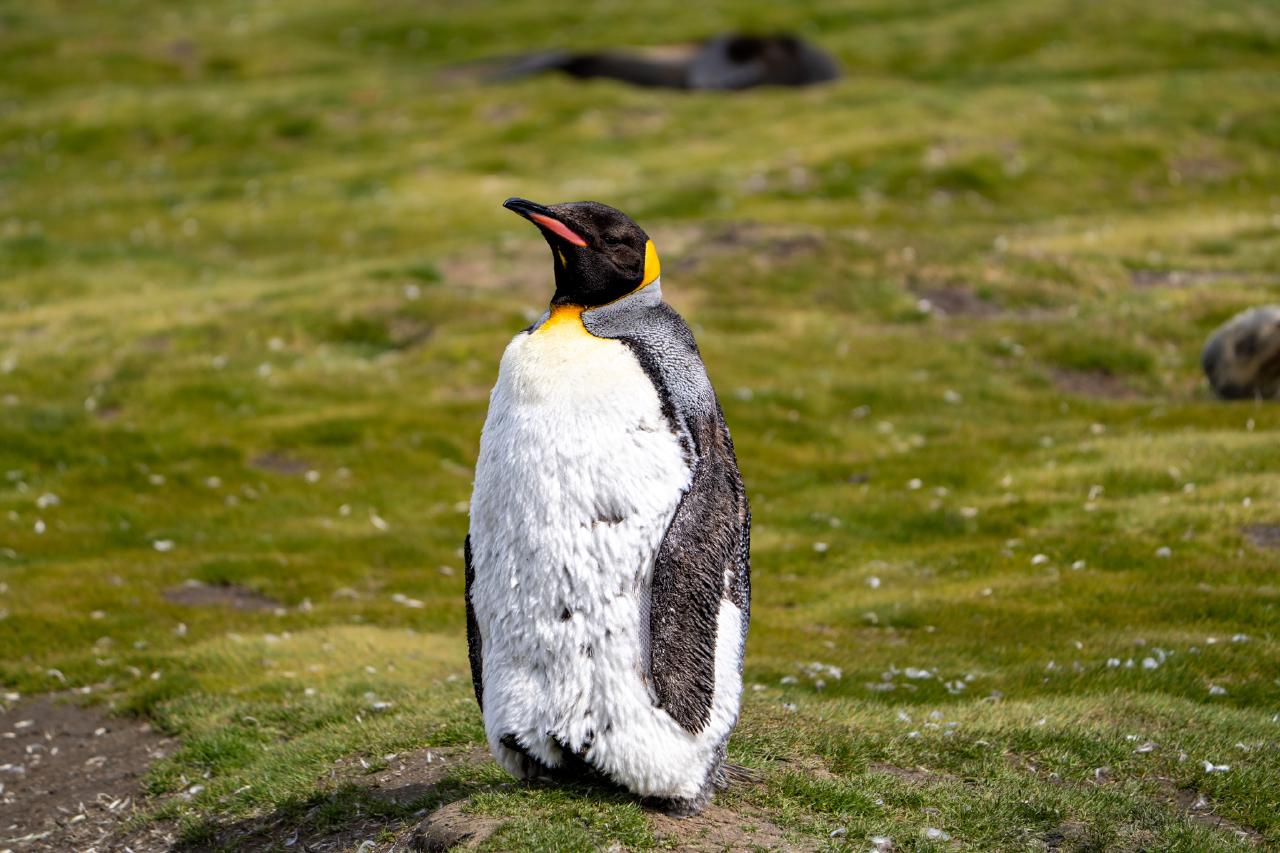
A penguin beginning its moult, surrounded by feathers
Arrival on the beach was a sensory overload. Penguins stretched out as far as the eye could see in every direction. The stench of guano was strong and carrying in the wind. There were feathers everywhere, littering the ground and blowing in the wind. The mould gave me shortness of breath and made me cough. The chicks crying out and echo of seals calling was a constant song. The wind whipped at our faces. We moved among the vast colony trying to take it all in.
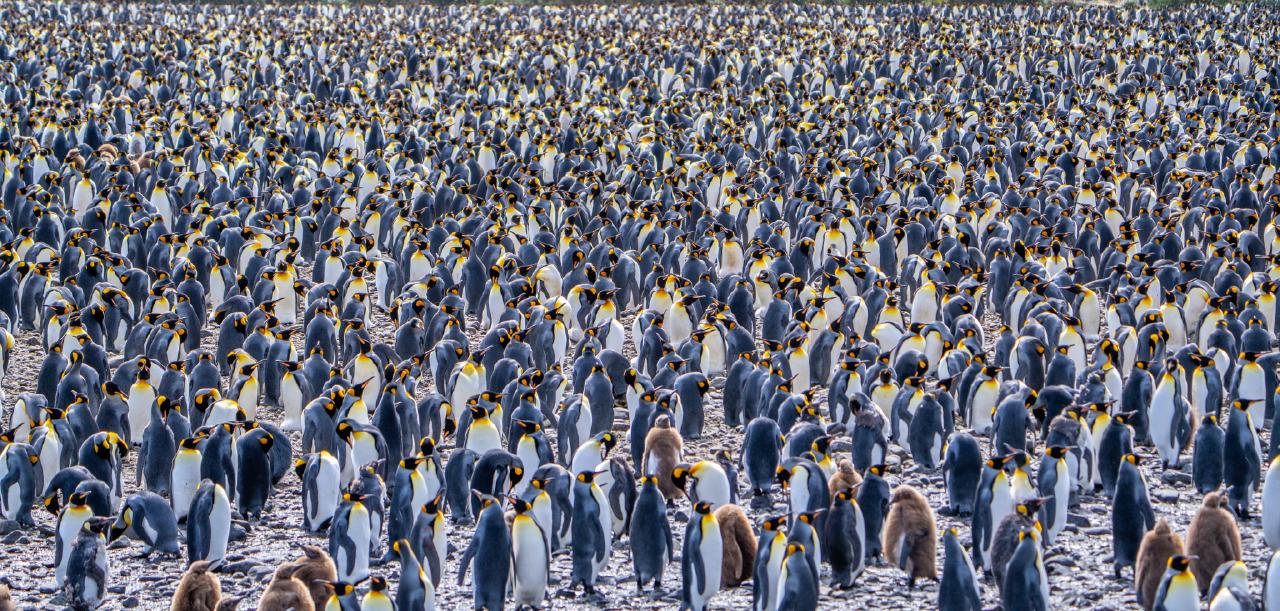
The king penguin colony at Salisbury Plain
There were thousands of chicks - some still completely covered in their brown downy fluff, and others who were variously progressed, which often resulted in an amusing creature somewhere between teddy bear and penguin.
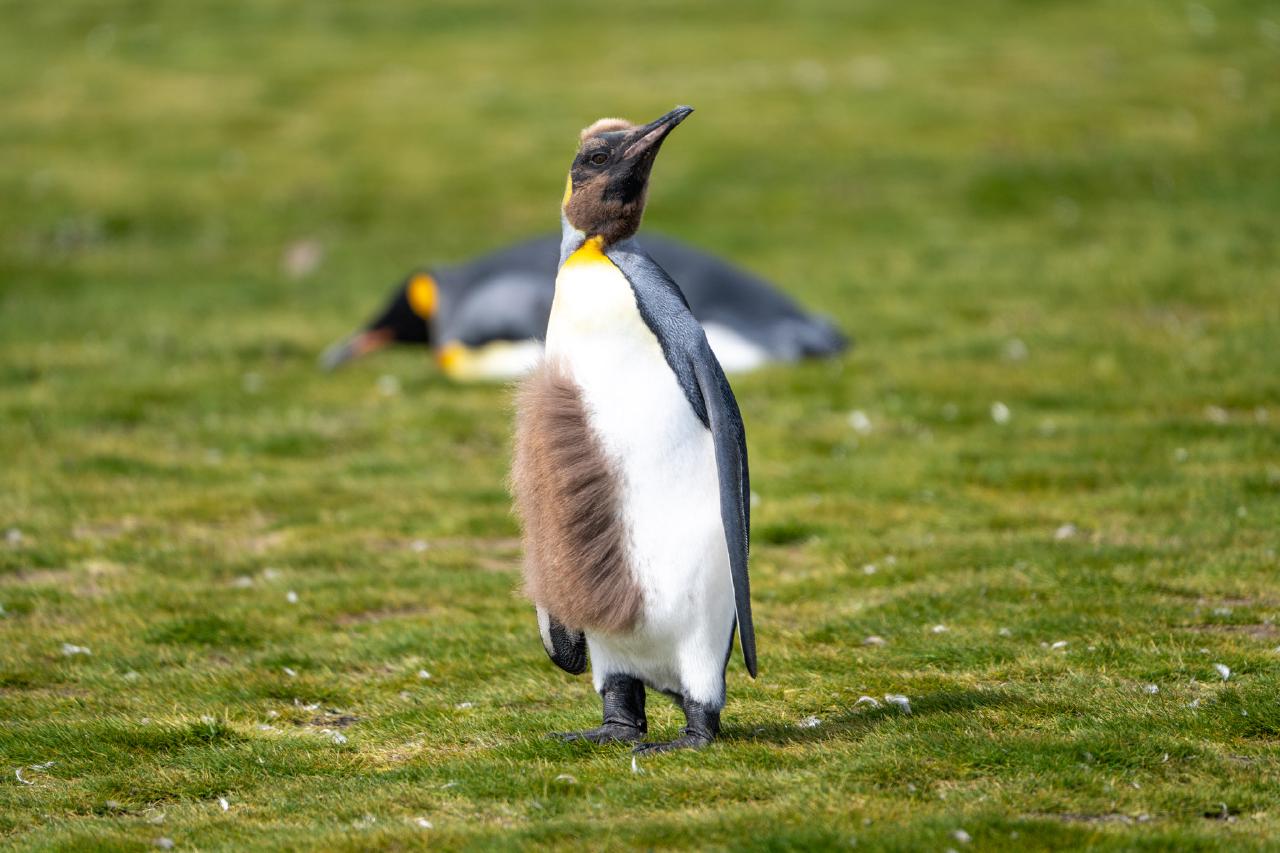
A penguin chick transforming
We struggled to find a clear path, maintaining a respectful distance from the individuals, as we made our way to the top of the colony through the criss-crossings of penguins and seals, whose constant movements and interest in us made the cone placements put out by the guides to mark our intended walking path almost instantly redundant.
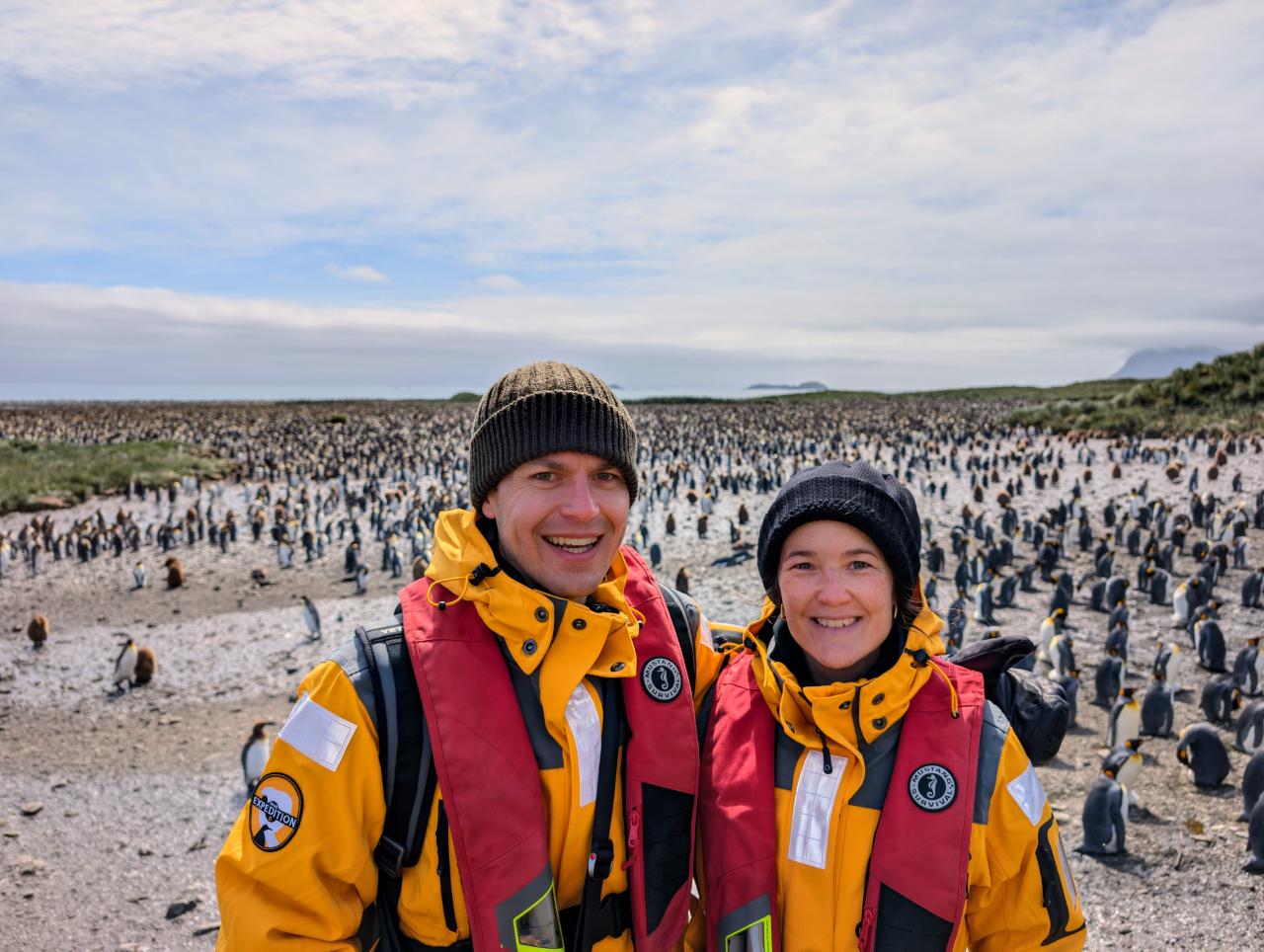
Somewhere in between the top and the bottom of the colony
It was an astonishing site seeing tens of thousands of penguins spread out before us, framed by the rising wall of glaciers beyond. Photographs cannot capture the impressive scene and cacophony of sounds that enveloped us on that plain.
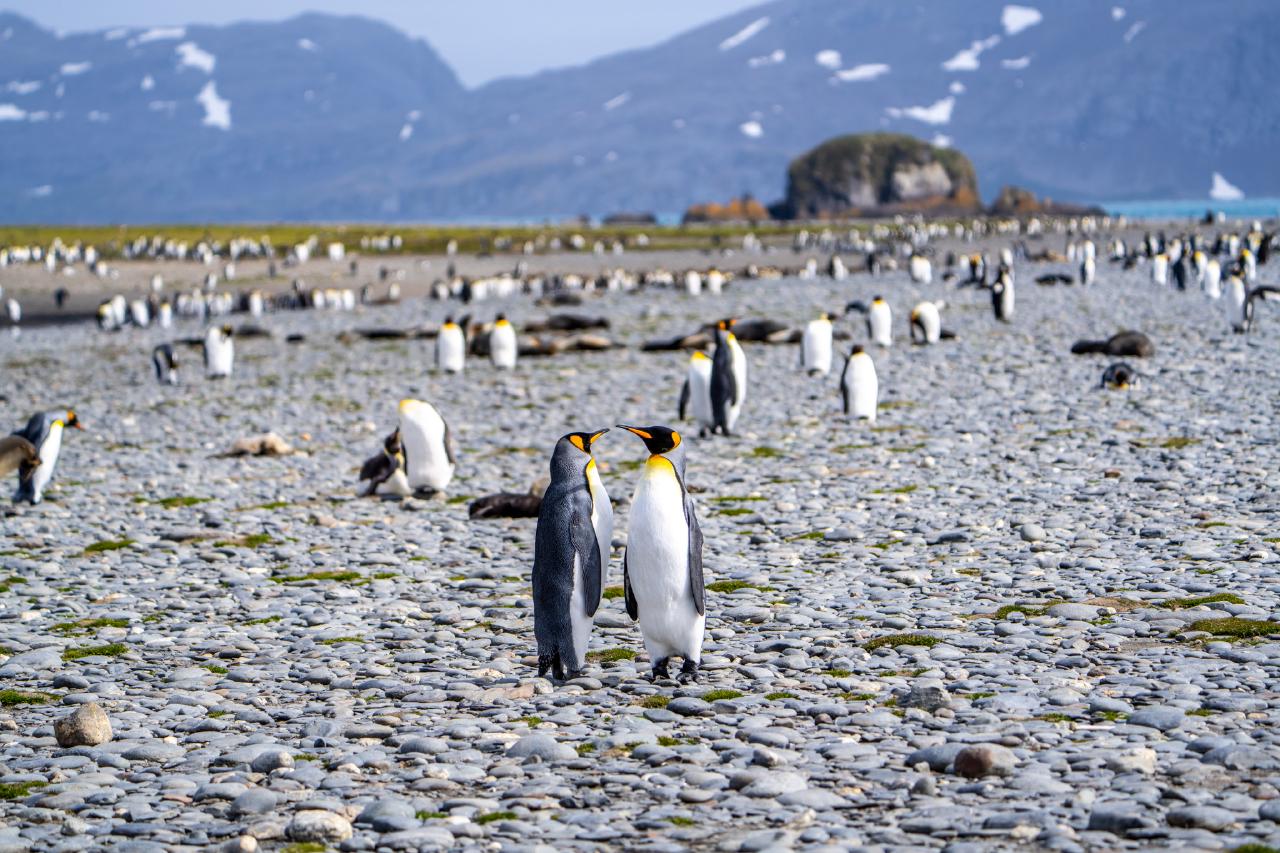
13 January, Cooper Bay + Gold Harbour
After another early start, we joined our zodiac cruise around Cooper Bay, which lies on the south-east extremity of South Georgia, and is home to South Georgia’s largest macaroni penguin colony. As I pulled back the curtains to bring light into our dark cabin, we were treated to a beautiful view. Just beyond the ship was a beach speckled with penguins, and behind the beach sat two conical mountains rising high into the blue sky, a sloping white glacier spread out in the carved valley between the two. Out beyond the island was a large cluster of icebergs, lying frozen in varying shapes and sizes of glittering white ice, their submerged bases turning the subsurface waters a luminescent turquoise.
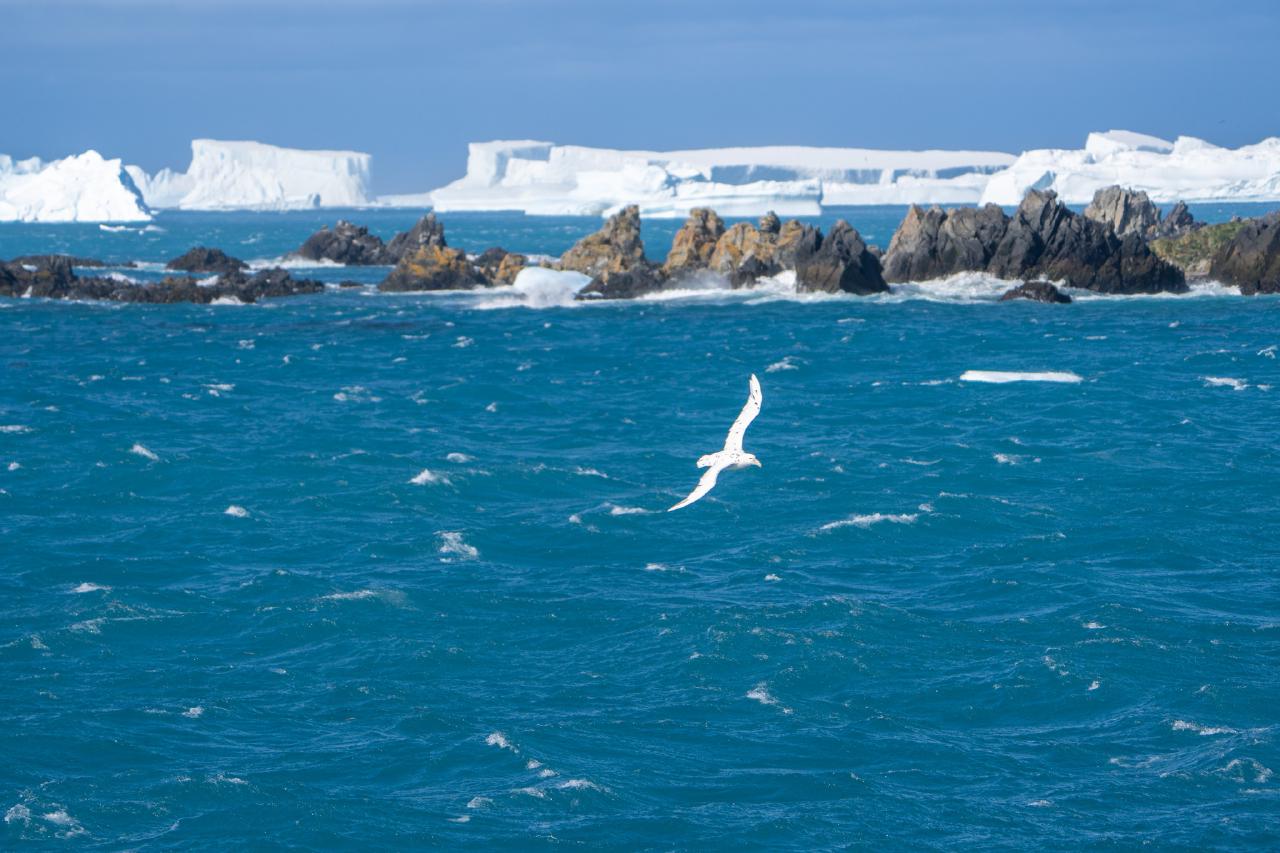
A white morph southern giant petrel soaring over Cooper Bay
Unfortunately, however, there were strong gusts of wind exceeding 40 knots and so our zodiac cruise was cancelled. Instead, we spent the morning standing on the outer decks at the stern and photographing the birds soaring on the wind around the boat and the seals and chinstrap penguins frolicking in the waters below.
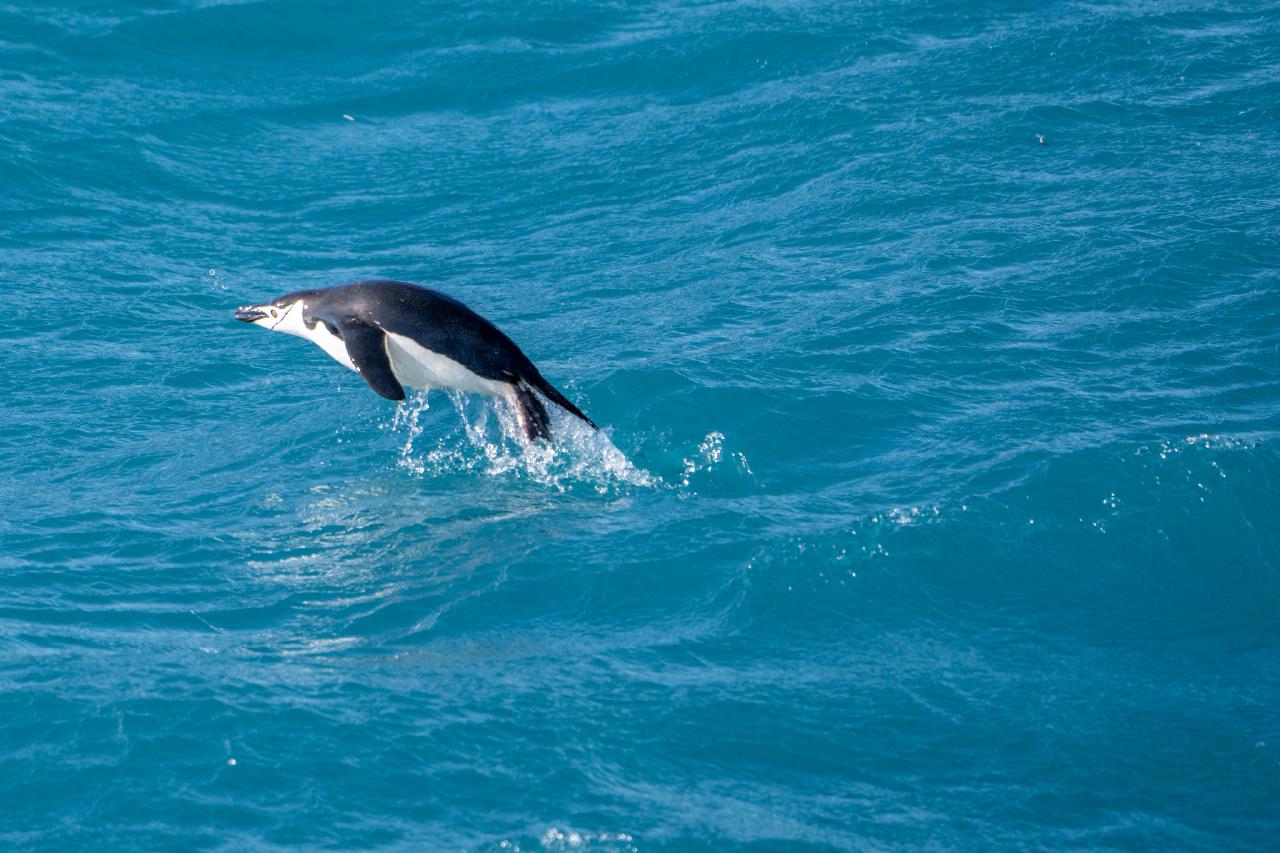
A chinstrap penguin at Cooper Bay
In the afternoon, we departed Cooper Bay for Gold Harbour. The winds continued to pick up as the storm swirled around us and so once again our zodiac cruising was cancelled. Instead, we took the opportunity to do some exercise in the gym. As the ship left the protection of Gold Harbour, the swell picked up and we truly felt the motion of the ocean. I very quickly started to feel ill. After a quick shower and some medication, I got into bed and placed my eye mask over my eyes in an attempt to block out the visual indicators of motion at least. I barely left the bed for the next two days.
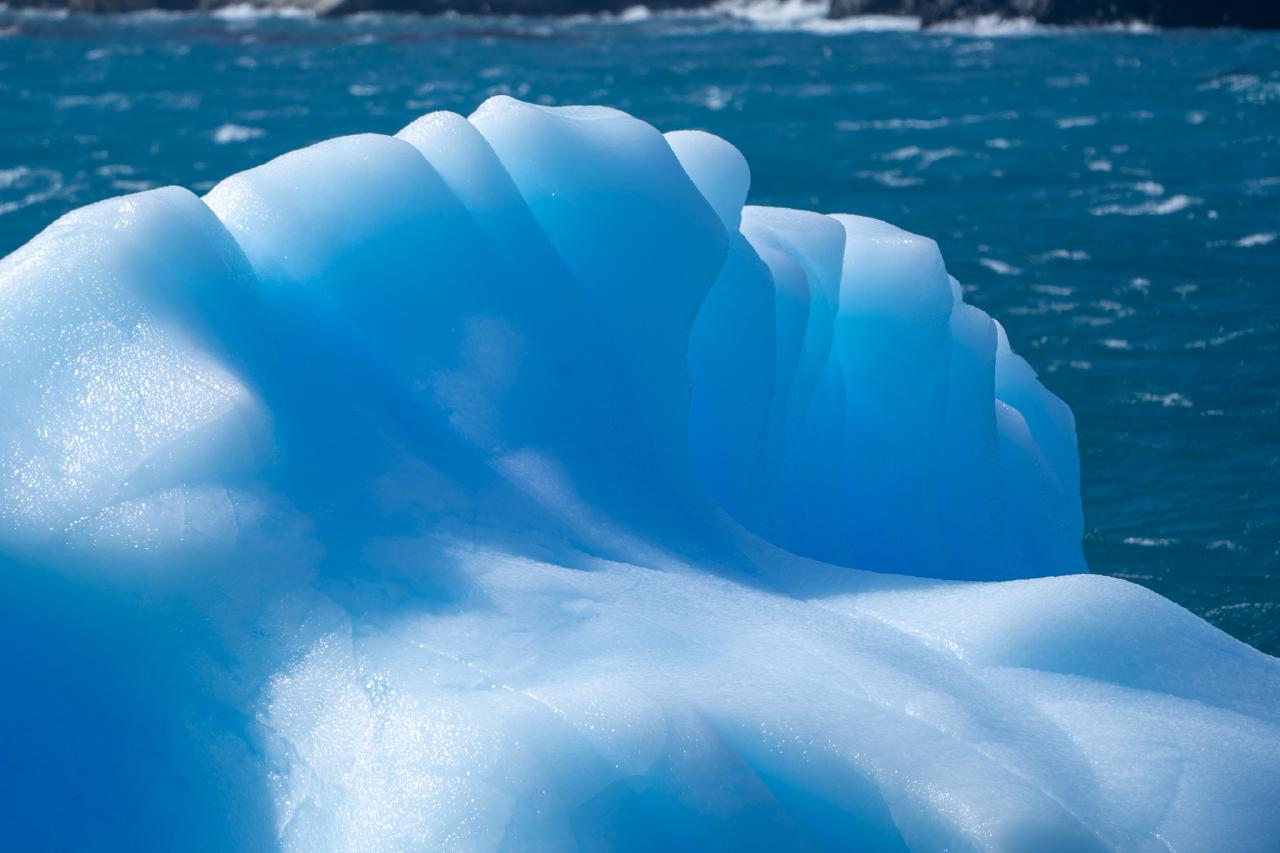
14 and 15 January, At sea
The next day we continued our journey at sea as we entered the 60th parallel south: a vast nothingness of ocean and the invisible boundary of the Southern Ocean.
Dylan and I both spent most of the day in bed, either sleeping from the drowsiness of the medication or watching old Antarctica documentaries. We didn’t even make it to the auditorium for the lectures, instead choosing to watch them from our cabin. It was great that they livestreamed everything to the TVs in the rooms, allowing you to not miss any talks when you were incapable of moving about the ship. We only managed to leave the room for meals. By dinner though, the seas had calmed a little and we joined guests in the level 4 lounge for the evening bar talk after dinner.
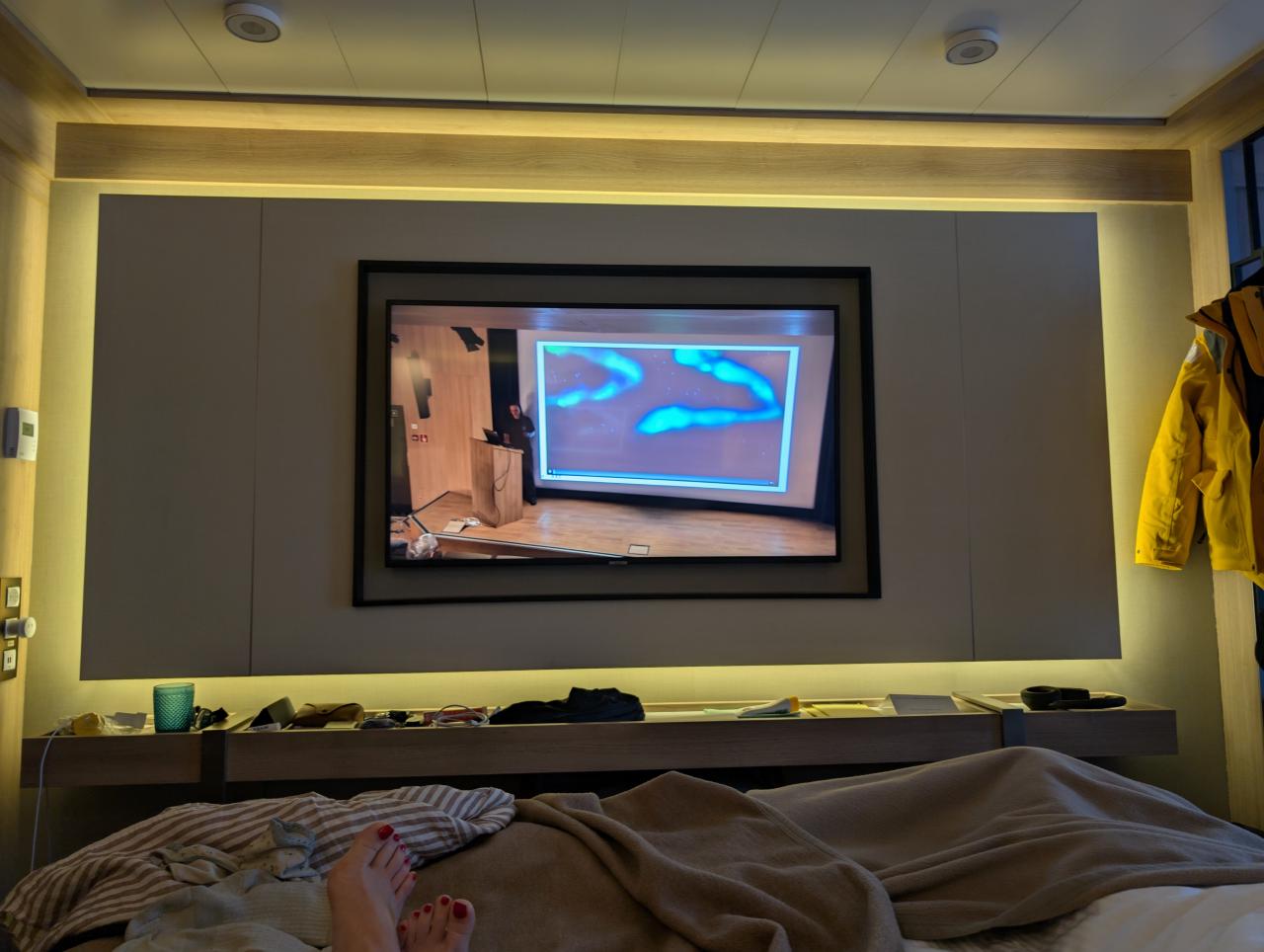
Watching a lecture from the comfort of our cabin
The following day was another full day at sea. The seas weren’t as rough and we were feeling well rested so managed to join the lecture in the auditorium after breakfast and go to the gym for another workout. In the afternoon, we had to complete our biosecurity procedures to prepare for our landings in Antarctica, once again checking our gear for dirt, seeds or other organic material from South Georgia that we would need to remove to avoid introducing to Antarctica.
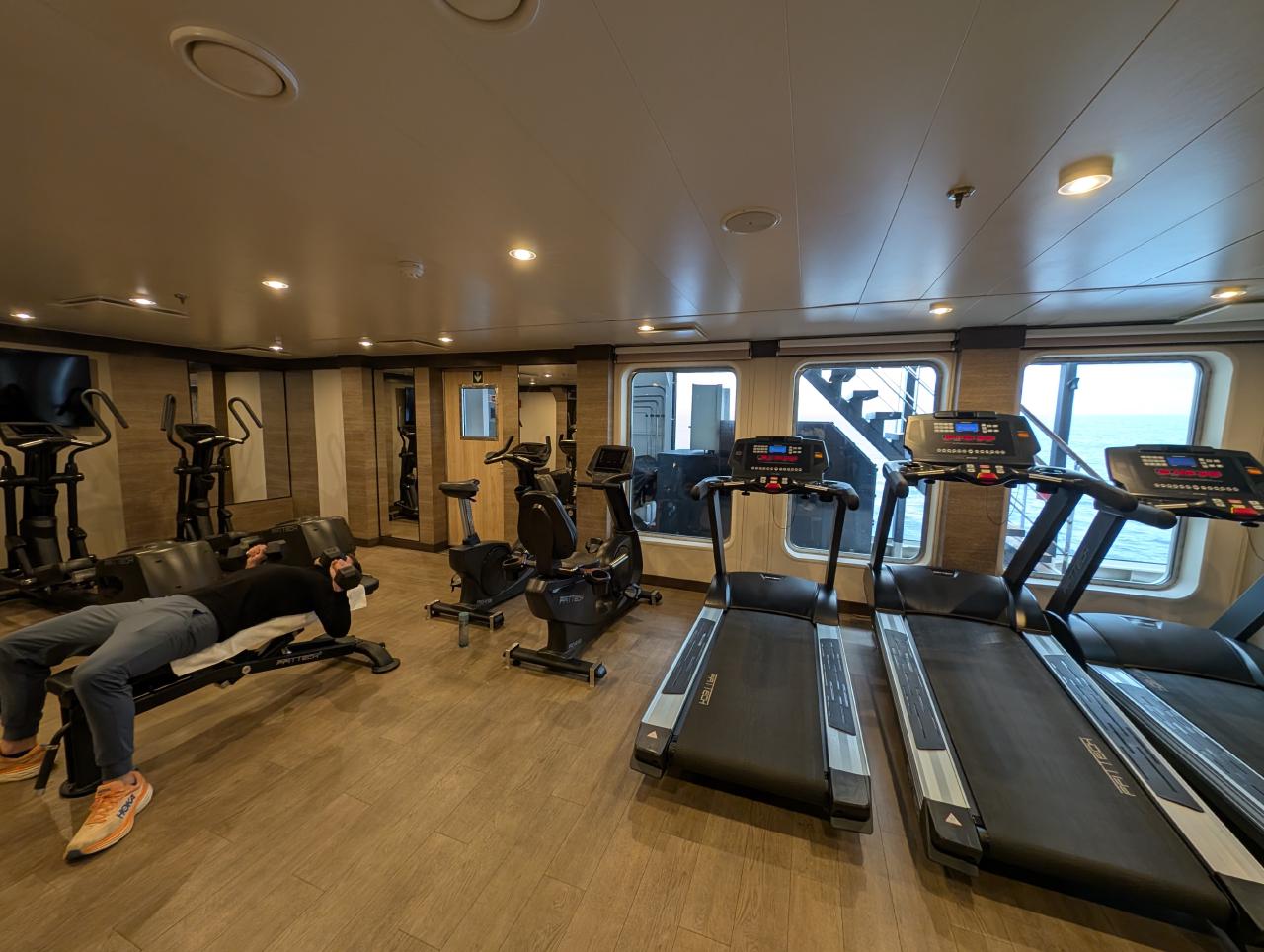
Working out at the gym
16 January, Elephant Island, Point Wild + Chinstrap Camp
We were expected to arrive at Elephant Island by 8.00am but were a little late due to the weather. Our excursion group – the green group – was up first for the zodiac cruise, if weather permitting, we could go.
We arrived near Point Wild, but there was too much sea ice and wind to go on an excursion at our planned location, so the captain took the ship around to Chinstrap Camp where we could find a large chinstrap penguin colony.
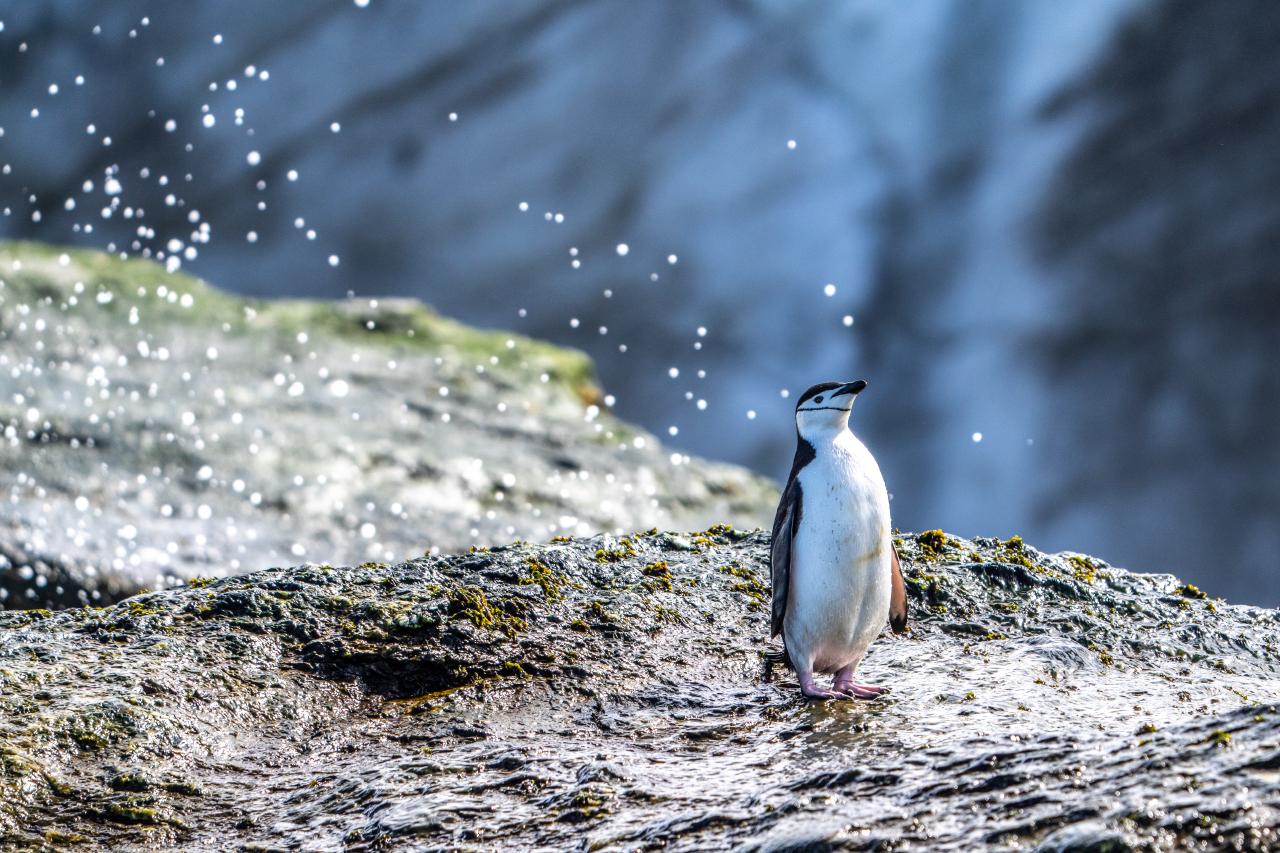
A chinstrap penguin at Point Wild
We were able to go on our excursion, but the swell was still substantial so getting on and off the zodiacs at the gangway was a challenge, each step needing to be timed with the rise and fall of each surge. We were drenched with water as our zodiac, the first off the gangway for the day, made it towards the shoreline. Our waterproof gear held its own and we remained dry and warm inside our layers despite the large splashes of waves hitting us.
Despite the wetness and movement, it was a fantastic cruise. We spent a little over an hour manoeuvring among the waves and rocky coastline, our zodiac driver expertly navigating the zodiac to get us as close as possible to the shore without risking a collision with the rocky shoreline. We saw chinstrap penguins, and finally, the macaroni penguin. Even though it wasn’t a a macaroni colony there were a few hanging around, and so we checked another box on our penguin safari!

A macaroni penguin, with its distinctive eyebrow crown, and a chinstrap penguin behind it
It was possibly the most challenging photographic conditions I’ve experienced; the swell of the waves rocking the boat, the water splashing the lens, the constant rise and fall of the zodiac. I crouched on the rubber mat at the bottom of the zodiac, well placed at the front, and just rapid fired shots as soon as I could get focus on a penguin. It was a fun challenge to capture the character of the penguins and the conditions of the day.
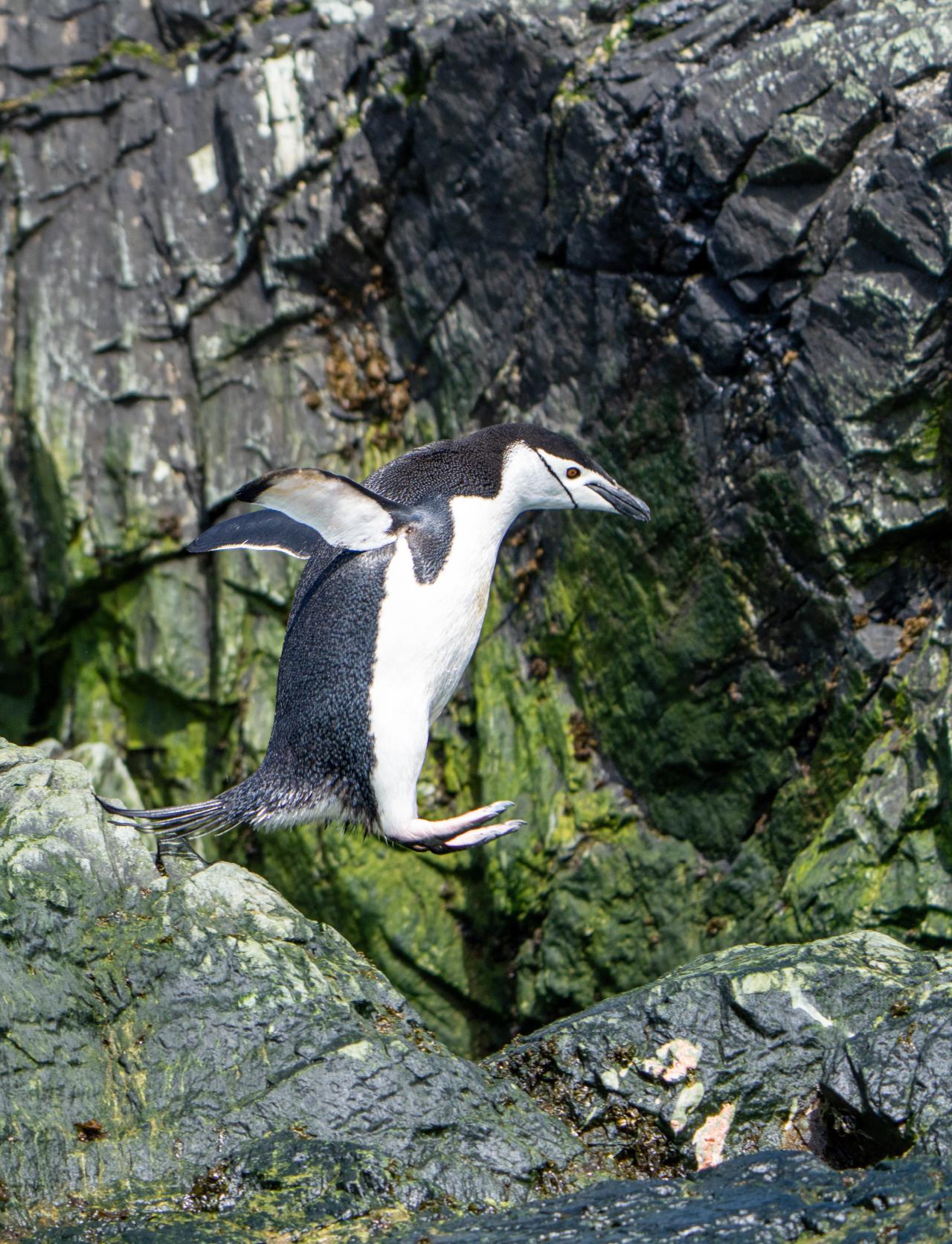
A chinstrap jumping between rocks
After our excursion, and a late lunch, we continued our journey, with high anticipation, to the Antarctic Peninsula.
Read on for part 2…
